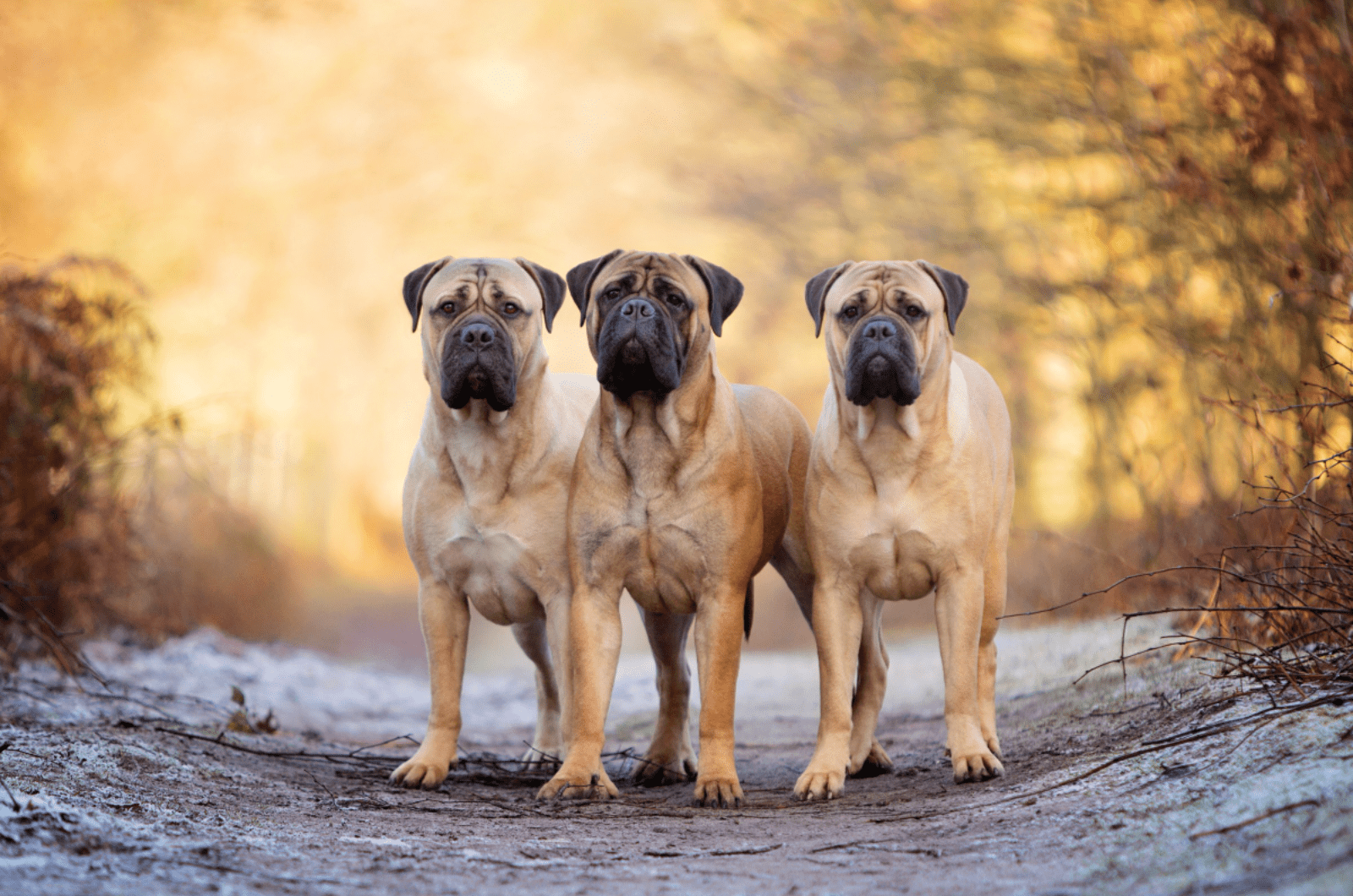We have gathered all canines that are considered the best Mastiff breeds in our list for all dog enthusiasts that are interested in these types of dogs.
Mastiffs have been known as working, herding, and war dogs throughout history, which isn’t a surprise considering their sturdy stature and massive body structure.
All of the canines from our list are excellent examples of Mastiff breeds. They share many similarities, but each of them has a certain set of distinctive features that tells them apart from other Mastiff dogs.
If you’d like to know more about the best Mastiff breeds, all you need to do is keep on reading this article!
29 Best Mastiff Breeds
Mastiffs have their pros and cons, but generally, they are great types of pups, especially for people who are looking for a more robust type of pet.
Keep in mind that they love to bark and chew, so you’ll have a lot of work during training, especially if you go for a more stubborn type of breed.
If you love your pup and cherish all of its qualities but don’t know how to handle excessive barking and biting, you might want to look for dog training collars on Chewy, Amazon, or other online shopping sites that sell dog equipment.
Without further ado, we present you with the best Mastiff breeds from all over the world:
1. Tibetan Mastiff
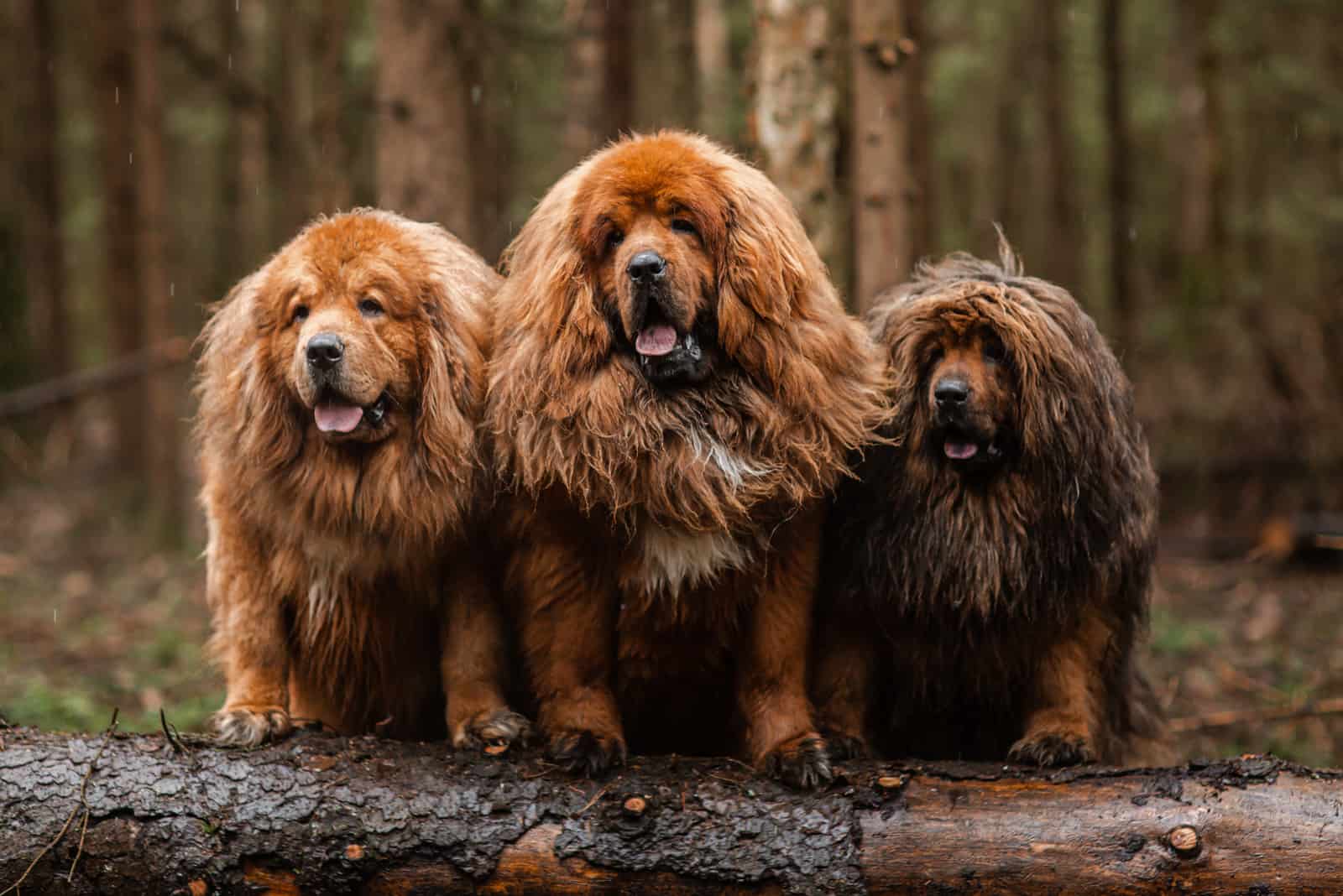
This is one of the ancient dog breeds that has been considered observant, unapproachable, arrogant, and imposing, mostly because of their physical appearance.
Tibetan Mastiffs like exercising their freedom and making it clear to their owners how much they value it.
Therefore, you should not spend your time by tossing stuff in the hopes that it will be retrieved.
Instead, you should plan to take them out for long walks at least once or twice a day. It’s also recommended to change the walking path every now and then, as these pups love to explore new territories.
They can be loyal to their owners and act like guard dogs, but they definitely require mutual respect from their owners, or else they’ll turn into strong-willed canines that will rarely obey any commands.
That is why it’s necessary to start with obedience and socialization training from early puppyhood.
RELATED: 13 Best Tibetan Mastiff Breeders In The U.S.
2. Spanish Mastiff
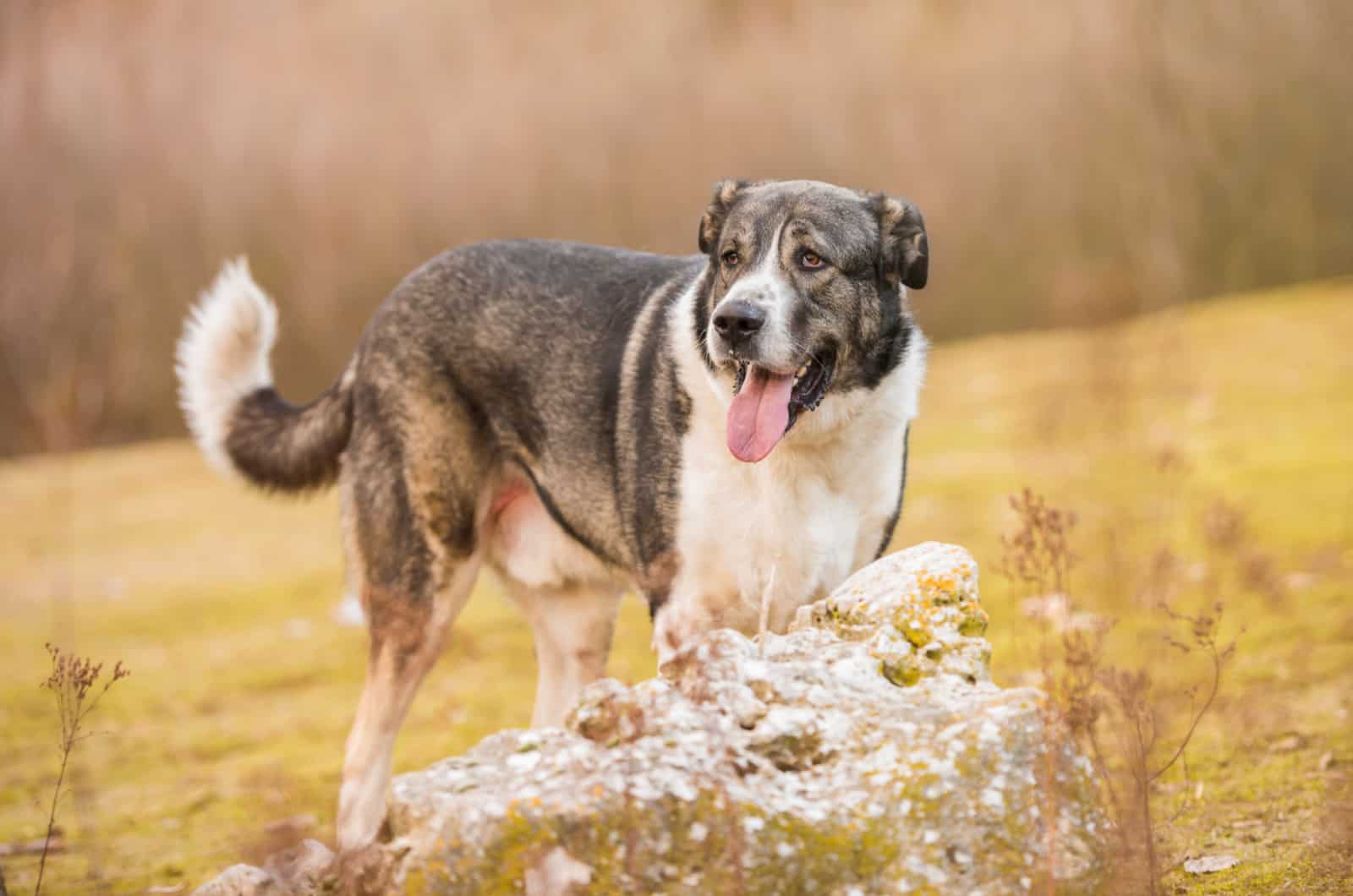
These gentle giants are considered one of the best Mastiff breeds because of their kind demeanor and great strength that they possess, like the majority of Mastiffs.
These pups are popular as herding dogs; their main role was to protect and herd Merino sheep. Although many people use them as family dogs nowadays, some Spanish Mastiffs are still being employed as herding canines.
These pups are exceptionally smart, but they can also be quite stubborn, so they shouldn’t be left alone for a long time without the owner’s supervision.
They’re peaceful and don’t often show signs of aggression but will react in case they feel threatened by a stranger (be it a human or another animal).
Overall, it can be said that these pups have sweet and lovable personalities, with a touch of strong will but immense respect for their dog owners.
3. French Mastiff (Dogue de Bordeaux)
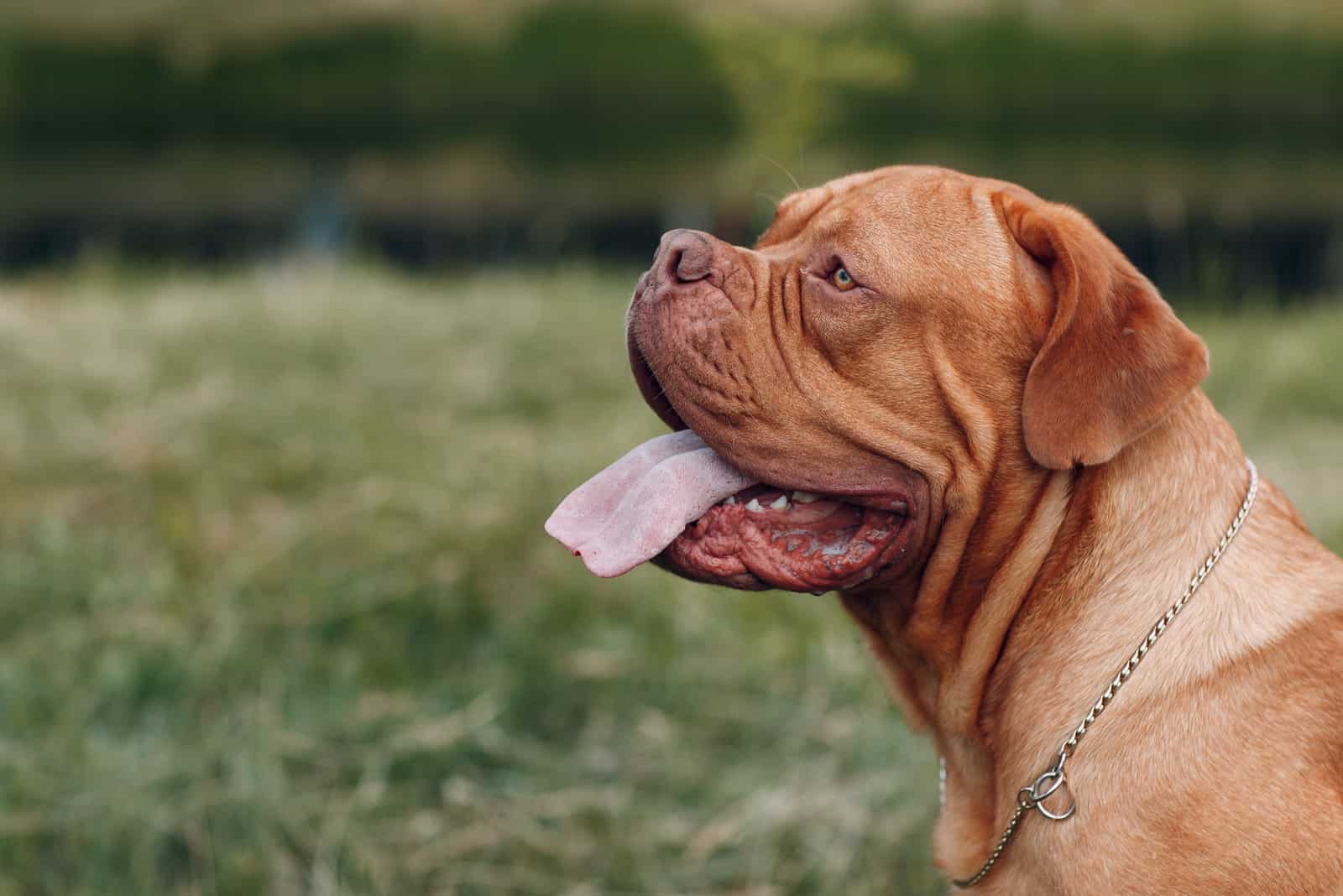
They are an excellent choice for a household that includes older children, as they’re not suitable company for babies and toddlers, at least not without adult supervision.
Because they are social dogs, they should be kept with people in a warm and caring home.
Just like its name says, this type of Mastiff dog breed comes from the French region of Bordeaux. It has existed for more than six centuries, but they haven’t become popular in the United States until the blockbuster “Turner and Hooch” was released.
After that, many people sought this specific breed, and they have been in demand ever since.
This canine is known to be a loyal and devoted pup, as it is completely dedicated to its human family, but keep in mind that it can also be quite strong-willed at times, which is one of the main characteristics of Mastiff breeds in general.
Dogue De Bordeaux canines are excellent guard dogs because of their loyalty, self-confidence, and territorial nature. They can compete in different sports, but they’re also great as therapy dogs, hunters, and search and rescue canines.
4. Abruzzese Mastiff
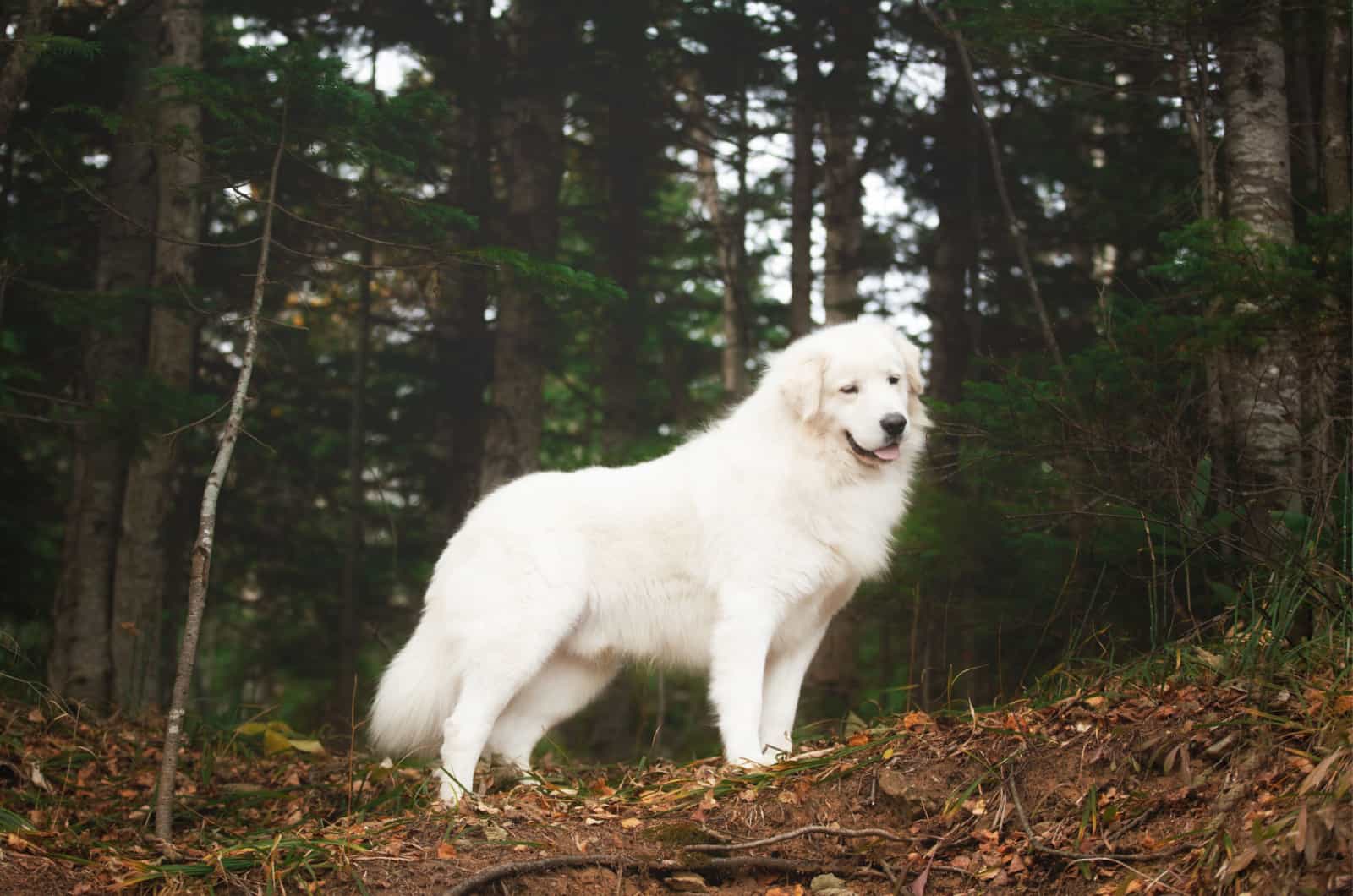
This is a big dog that is relatively uncommon, although they have been used as herding canines in the U.S. for a long time. They are a characteristic herding dog breed because they usually herd livestock in a pack consisting of at least four and at most ten canines.
The Abruzzese Mastiff is a canine known for its independence as well as its remarkable loyalty and devotion.
They could be reserved or timid among strangers, but their ability to alert their families to any potential danger by barking makes them excellent security dogs.
RELATED: Do Dogs Get Tired Of Barking? Dealing With The Annoying Woof
In spite of this, they are fast to warm up to people once they get to know them, and if they are appropriately socialized and taught, they may even get along with the children living in the house.
They share similar coat colors as Labrador Retrievers, white and cream shades, which is why they’re often compared to them, although they’re two different canine breeds.
5. Caucasian Shepherd
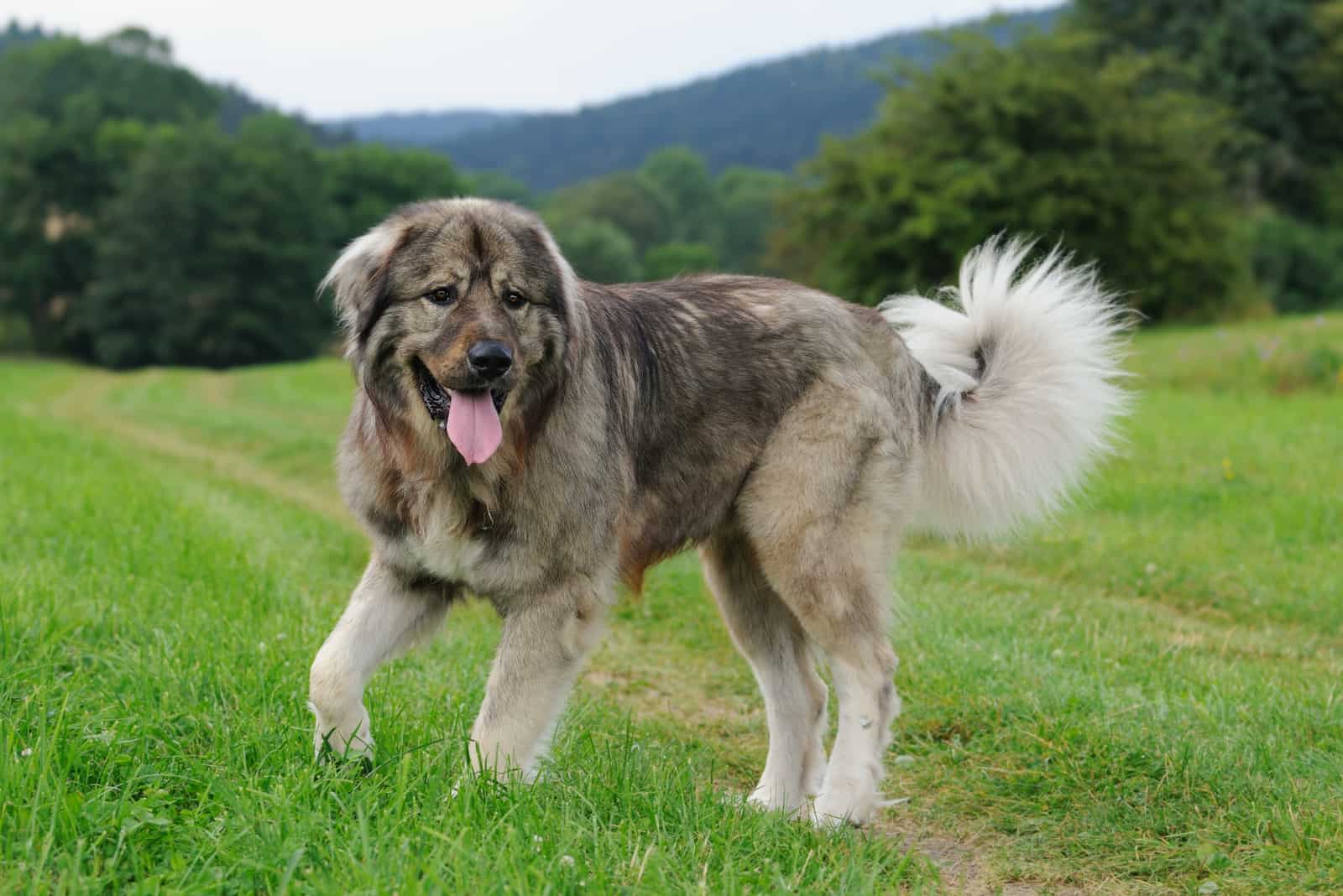
When we talk about fearless watchdogs of households among Mastiff breeds, there is one name that shouldn’t be skipped by any means: The Caucasian Shepherd, which is also known as Caucasian Ovcharka, Baskhan, or Russian Bear Dogs.
They were raised to protect livestock and the family home from large predators of the Caucasus Mountain area, which is known for its rugged terrain.
This enormous breed is extremely territorial and will not drop back from confrontation, even if it is facing a bear or a wolf. They have a high IQ, but because of their headstrong and rebellious personality, they can be challenging to train.
If an expert trainer is not present to keep them in control, their innate cautiousness around strangers and other animals might potentially lead to violent inclinations on their part.
6. Italian Mastiff (Cane Corso)
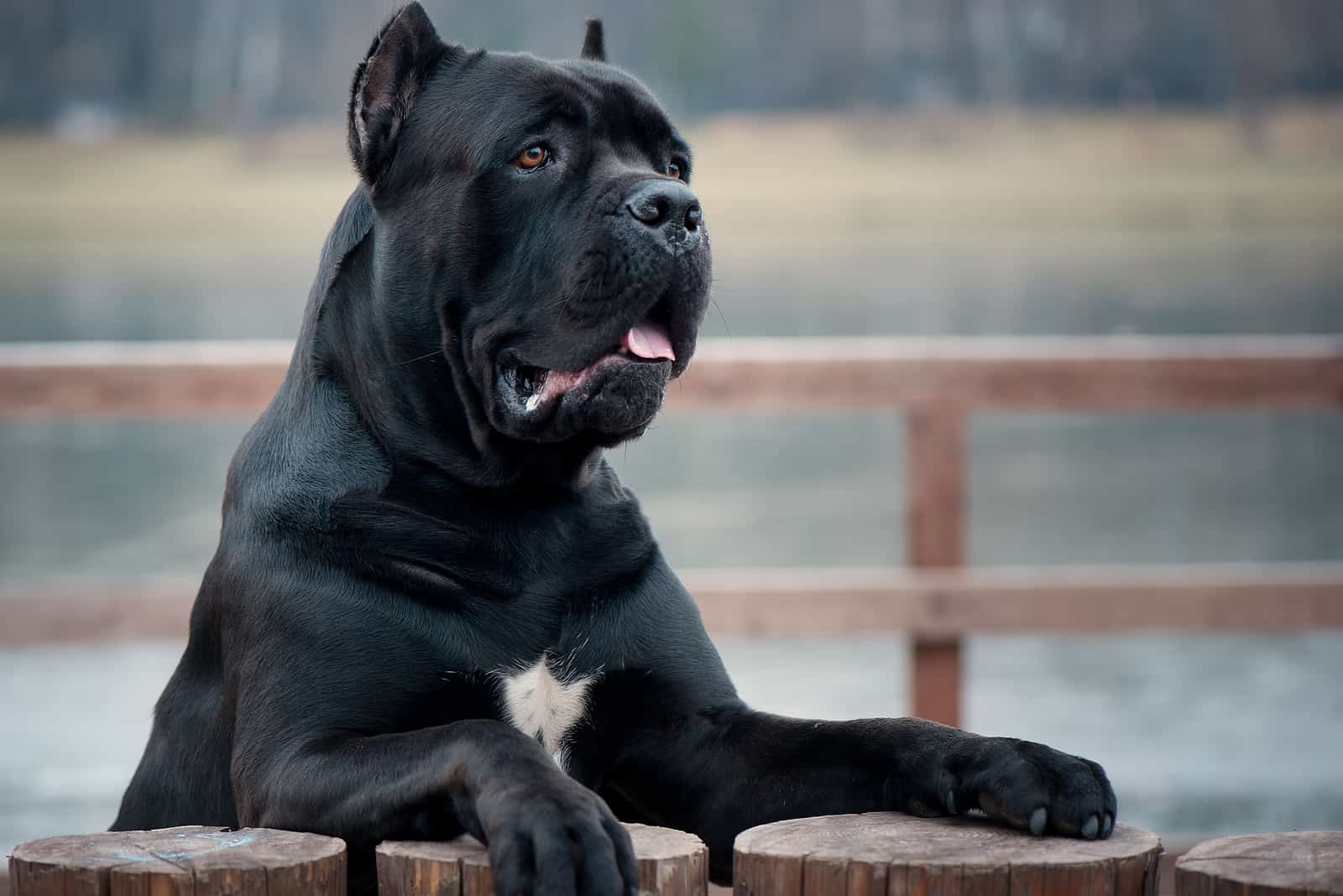
Cane Corso has been a devoted family pet for a long time throughout history, and their main role was to act as guard dogs and protect both their properties and dog owners.
This is one of the Mastiff dogs that has a strong urge to defend, which is why they’re wonderful dogs to have around families with young children.
They are kind and gentle big dogs, but Corsos will show signs of aggression if they feel that their dog owner or their family is in danger.
However, these pups might not be the best choice for first-time owners, as they do possess certain personality traits of Mastiffs, such as stubbornness and independence.
Cane Corsos are often compared to Presa Canario, which isn’t such big of a surprise, considering that they’re both part of the Mastiff breeds, although Corsos are colored in quite different coat shades than Canarios.
7. Dutch Mastiff (Pug)
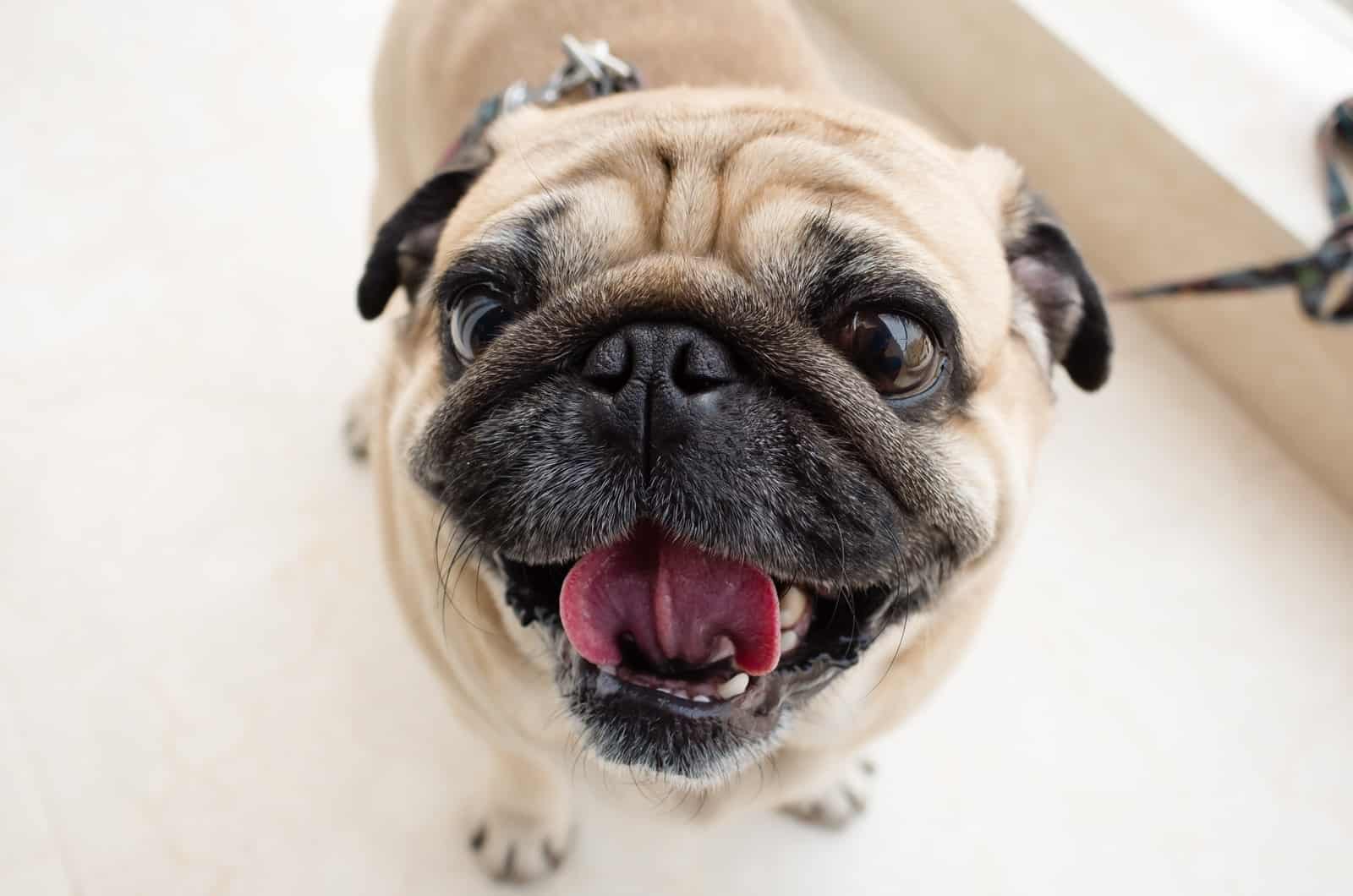
This is one of the most interesting Mastiff dog breeds, not because of their looks but because of their name. These pups are not from the Netherlands, nor are they Mastiffs.
However, when these doggies appeared in this European country for the first time, the Dutch people weren’t familiar with the name Chinese Pug, which is why they decided to call them Dutch Mastiffs.
That explains the “Dutch” in the name, and the “Mastiff” comes from their appearance, which resembles the characteristically Mastiff look with wrinkles and body frame.
They are known as lap canines, which is no surprise considering that they were bred to be furry companions of Chinese royalty.
Pugs are lovely canines with a laid-back attitude, even though they can be strong-willed from time to time, they’ll love to cuddle with you every time they have a chance to do so.
However, keep in mind that Pugs are prone to skin issues because of their wrinkles and folds, which is why they require high maintenance.
8. Turkish Mastiff
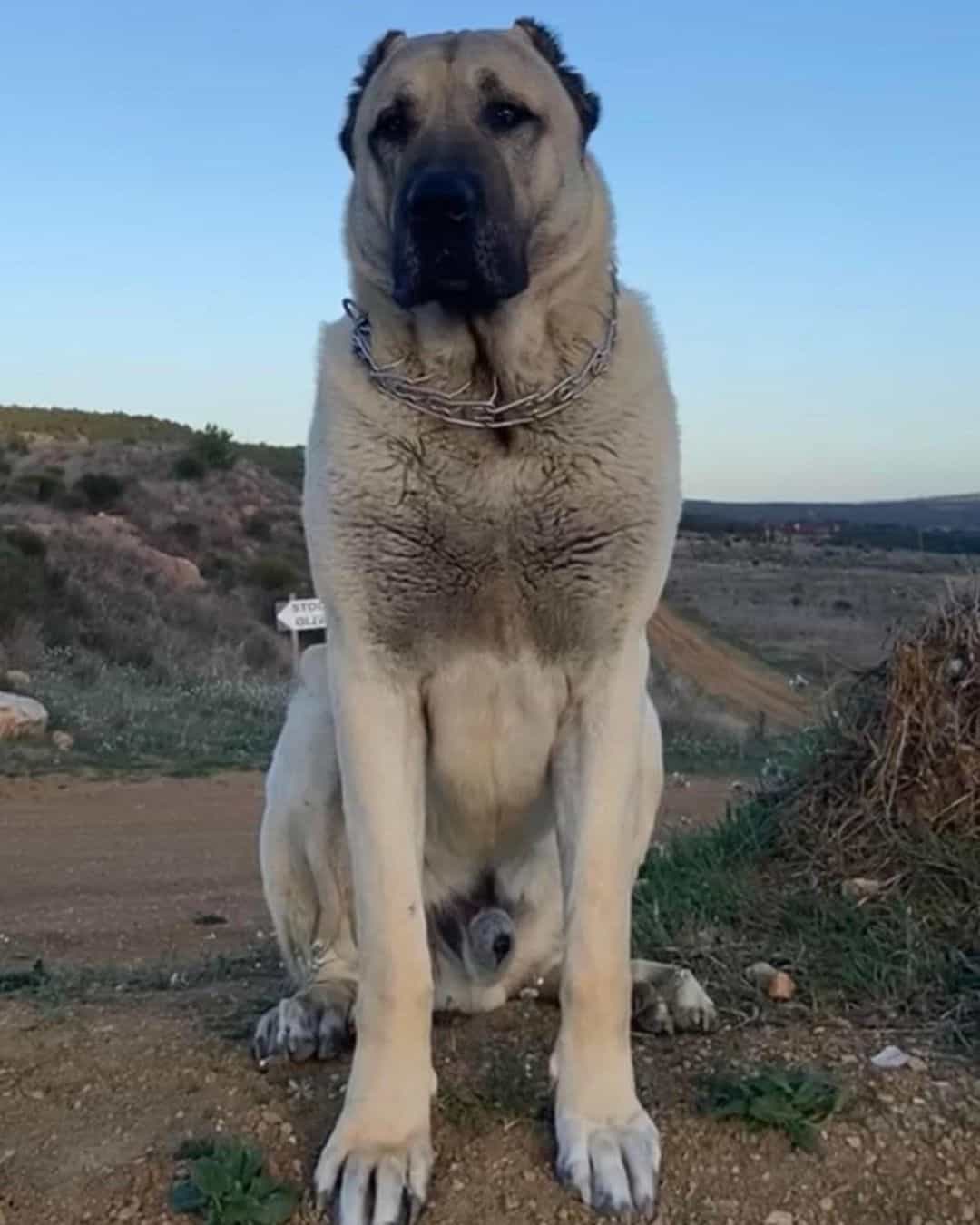
Photo from: @kangal_malakli_france
This is one of the less-known Mastiff breeds, which is also called Aksaray Malaklisi. They were named after the same-name Turkish province, although they’re internationally known as Turkish Mastiffs.
These large dogs were mostly used as livestock guardians in Turkey, although they are now familiar as family dogs because of their protective instincts.
They can grow up to 31 inches and are characterized by short greyish coats.
These pups might not be suitable for owners that don’t have prior experience with dogs because of their stubbornness and potentially aggressive behavior towards other people and animals.
Turkish Mastiffs might not be an easy breed of dog to train, but once you show dominance as their owner, they will obey you and show the utmost respect.
It’s also interesting to notice that these large-size dogs show resistance and hostility towards other canines of the same sex, even if they belong to the same breed.
9. Korean Mastiff
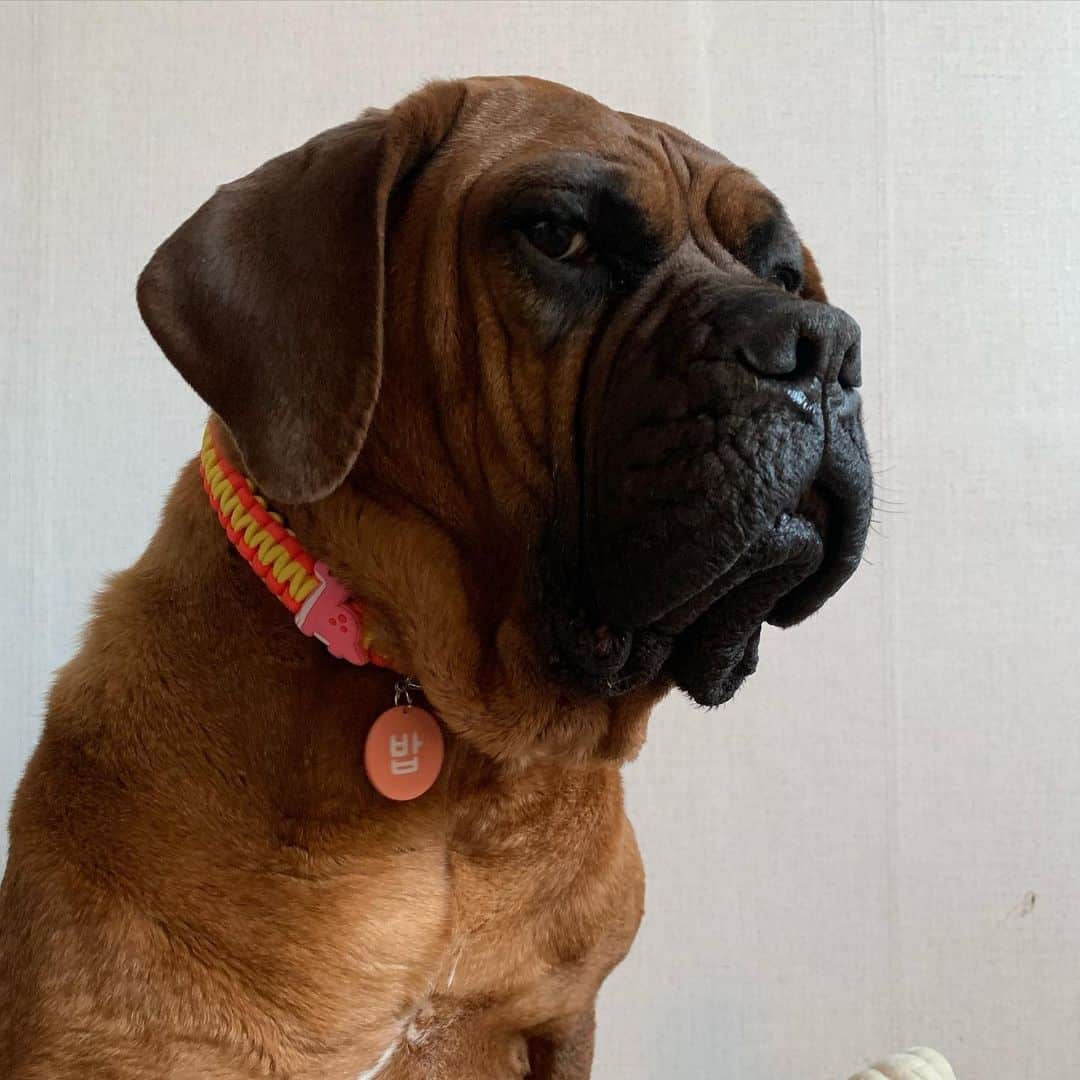
Photo from: @babsdiary
This wrinkly pup is one of the best proofs that large dogs also love to cuddle and behave like lap dogs. Although another name for them is Dosa Mastiff, most owners would agree that it should be “Cuddly Giant”.
This is actually one of the greatest differences between the Korean and other Mastiff breeds, as the majority of them are usually working dogs or guard canines.
It may be difficult to believe, given how serious and watchful they appear, but this friendly giant enjoys taking it easy. Because of their easygoing mentality, they are able to adapt well to any family and flourish when owned by caring people.
When you become the owner of this stately, dignified, and sociable canine, you will undoubtedly find yourself falling in love with it.
The fact that they have a kind personality does not negate the fact that they are devoted and watchful over those they care about.
In addition, the fact that they comply with instructions is the primary reason why they are simple to train.
10. English Mastiff
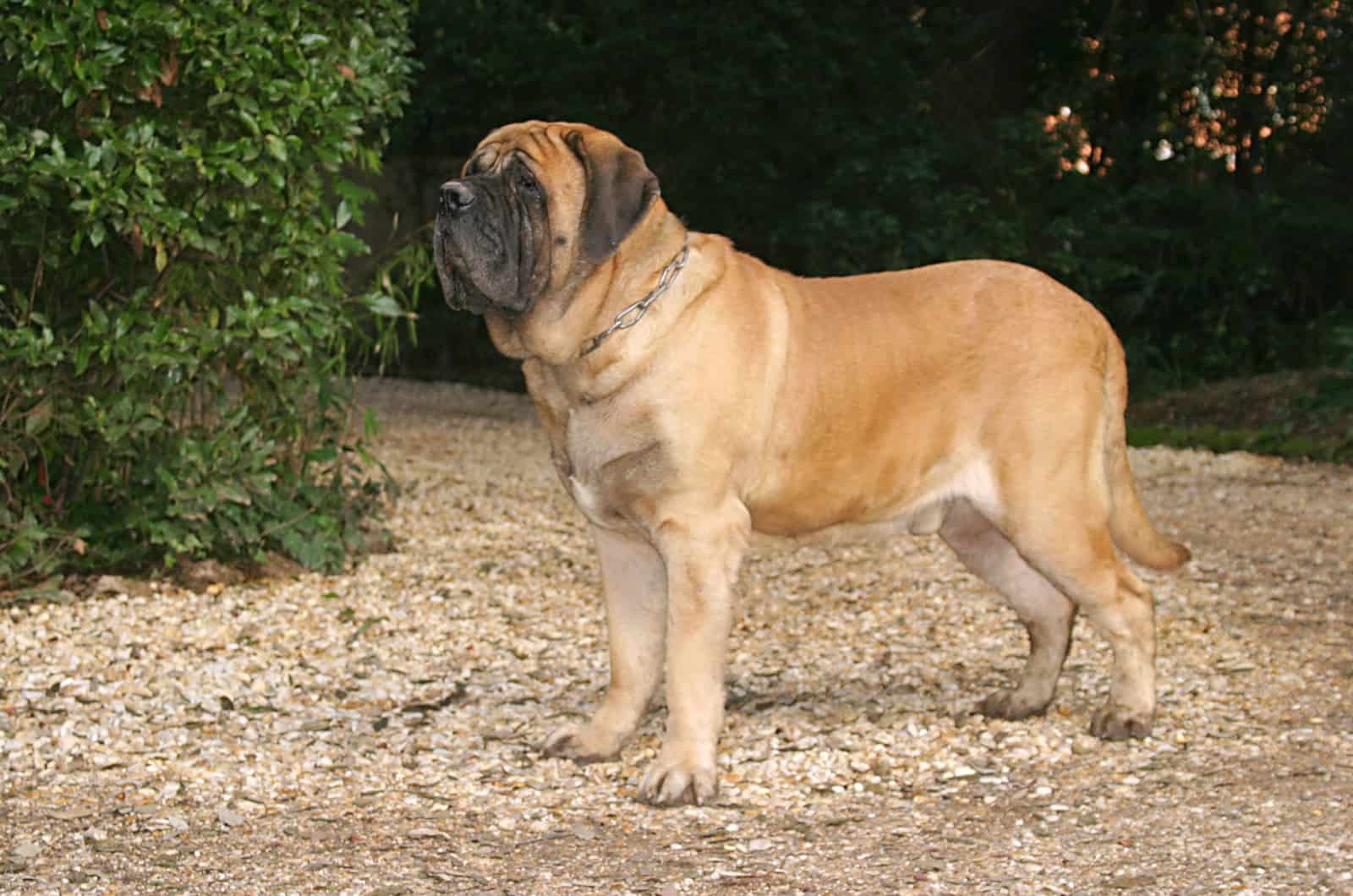
This is one of the best Mastiff breeds for most dog owners as they can function equally well as family and working dogs. They usually grow up to 36 in, which is why they’re considered one of the largest dog breeds.
This breed is often considered the original Mastiff, which is why the prefix English is often left out. Their homeland is England, and it is believed that these pups are descendants of the ancient breeds Pugnaces Britanniae and Alaunt.
The endurance, bravery, and power of English Mastiffs have earned them a well-deserved reputation throughout the years. Nowadays, most people consider them not just pets but family members.
If you have young children, all you need to do is ensure that these kind and gentle giants are aware of how to behave properly with your children so that there won’t be any mishaps.
11. German Mastiff (Great Dane)
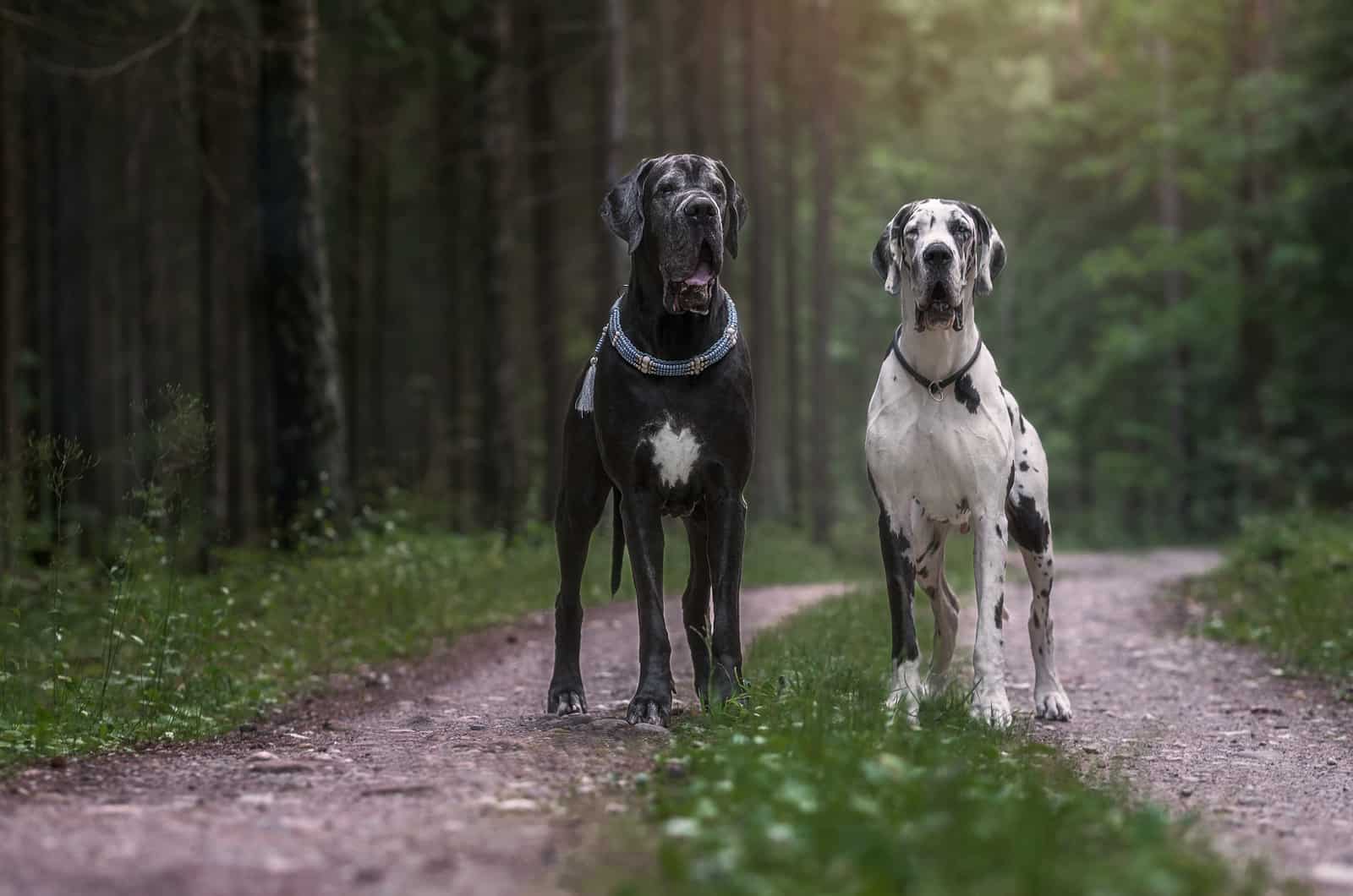
Great Dane, which is the popular name for German Mastiffs, is a very large and magnificent canine that looks more dangerous than they really are.
They are trustworthy, devoted, and loving, qualities that make them an excellent choice for any household. Having said that, you will still need to keep an eye on their behavior with younger children.
Great Danes come in a variety of shades and patterns, including blue, harlequin, mantle, fawn, brindle, merle, and black.
The German Mastiff has ears that are of an average length, depending on whether their ears are cropped or not. This breed requires high maintenance as they are known as moderate shedders.
This big dog adores every part of grooming, from having its hair brushed to having its nails trimmed.
12. American Mastiff
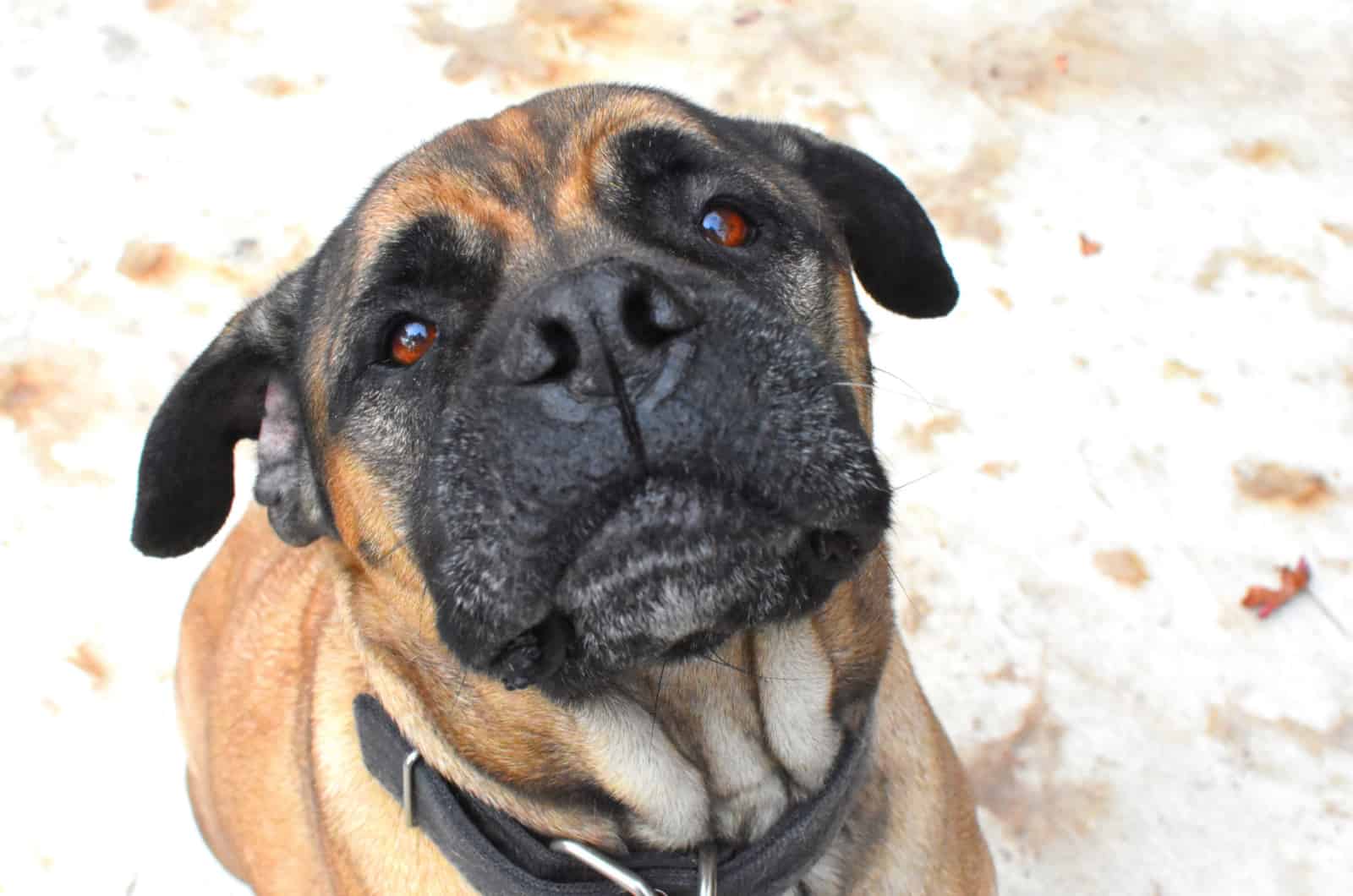
The American Mastiff is a large-sized, strong canine that differs somewhat from other Mastiff breeds in that it does not drool nearly as much as most Mastiffs do. This is one of their distinguishing characteristics.
These pups are also known as the North American Mastiffs, especially in this part of the continent.
The American Mastiff is one of the most patient and affectionate canines when it comes to children, despite its intimidating appearance and strong build.
It is believed that this pup is a descendant of the Anatolian and English Mastiffs, which is confirmed by the set of traits that American Mastiffs inherited from these breeds.
This is one of the healthiest breeds, although they prefer to lay around whenever they can, instead of running around or enjoying outdoor activities.
However, that doesn’t mean they don’t require daily exercise, which is why it’s important for you to take them out as much as you can.
You will need to use a lot of positive reinforcement during training, but it will pay off as you’ll get an obedient dog that will be affectionate towards the whole family, especially kids.
13. Pyrenean Mastiff
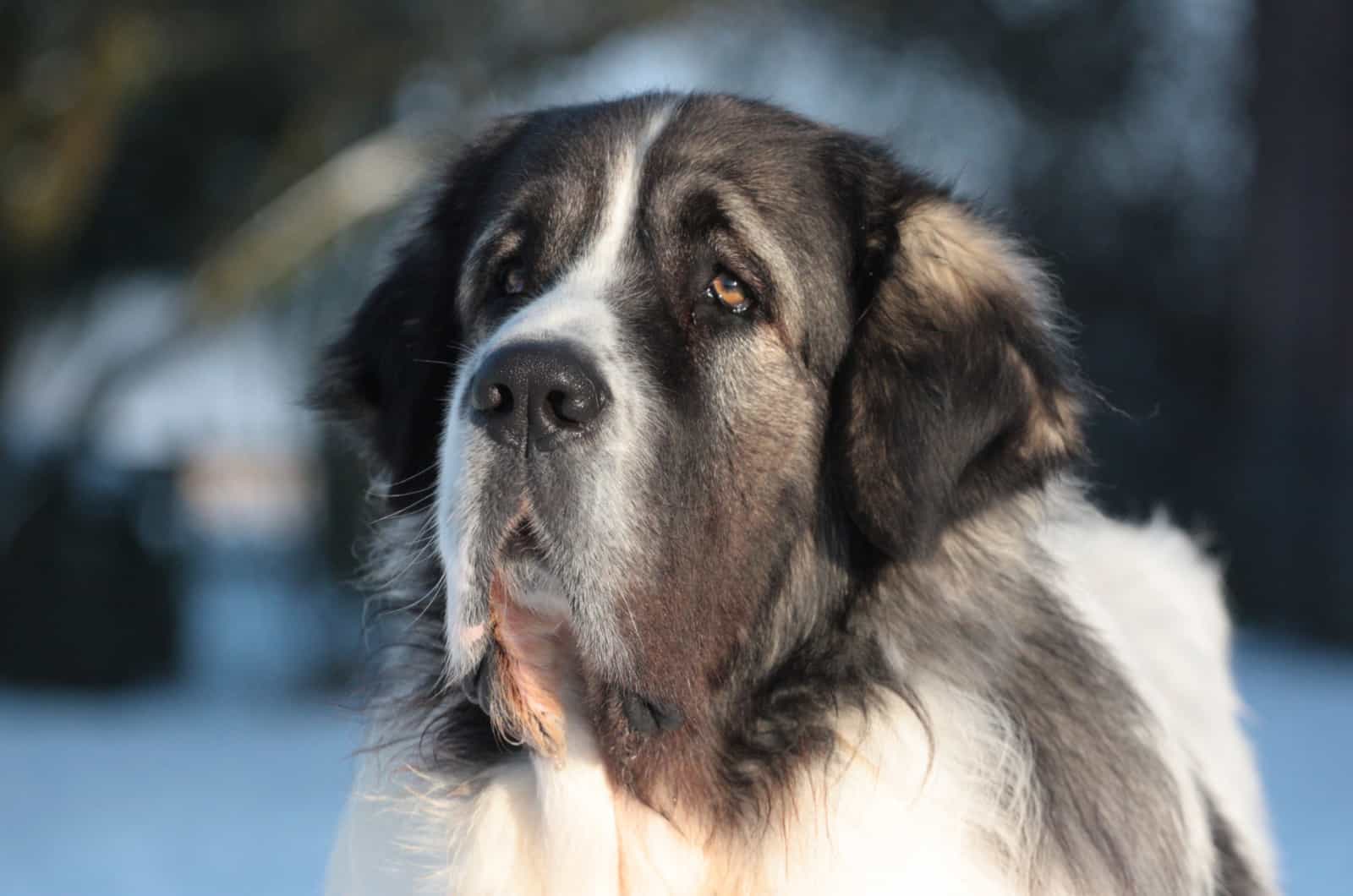
The Pyrenean Mastiff is often confused for the Great Pyrenees, although there are a number of differences between them, including lifespan, maintenance, drooling, size, fur shades, etc.
The Great Pyrenees are usually covered in red, grey, white, or tan shades, while Pyrenean Mastiffs sport a variety of hues, including dusk, medium grey, black, silver grey, sand, tan, red, and brindle.
This type of Mastiff dog breed descended from the Spanish Mastiff and is characterized by a remarkable disposition despite its great size.
Because of its exceptional geniality and tranquility, this Mastiff breed is ideally suited for families searching for large-sized canines to join their households.
The Pyrenean Mastiff interacts quite well with kids, although it is important to keep a close eye on them because of the possibility that their great size might endanger babies and toddlers.
Read Next: Maremma Sheepdog Vs Great Pyrenees: Clash Of The Titans
This type of canine is rarely interested in any type of exercise, as they prefer to lie down and rest throughout the day. However, they need to have at least daily walks and mental stimulation to develop in a healthy way, both physically and mentally.
14. Bullmastiff
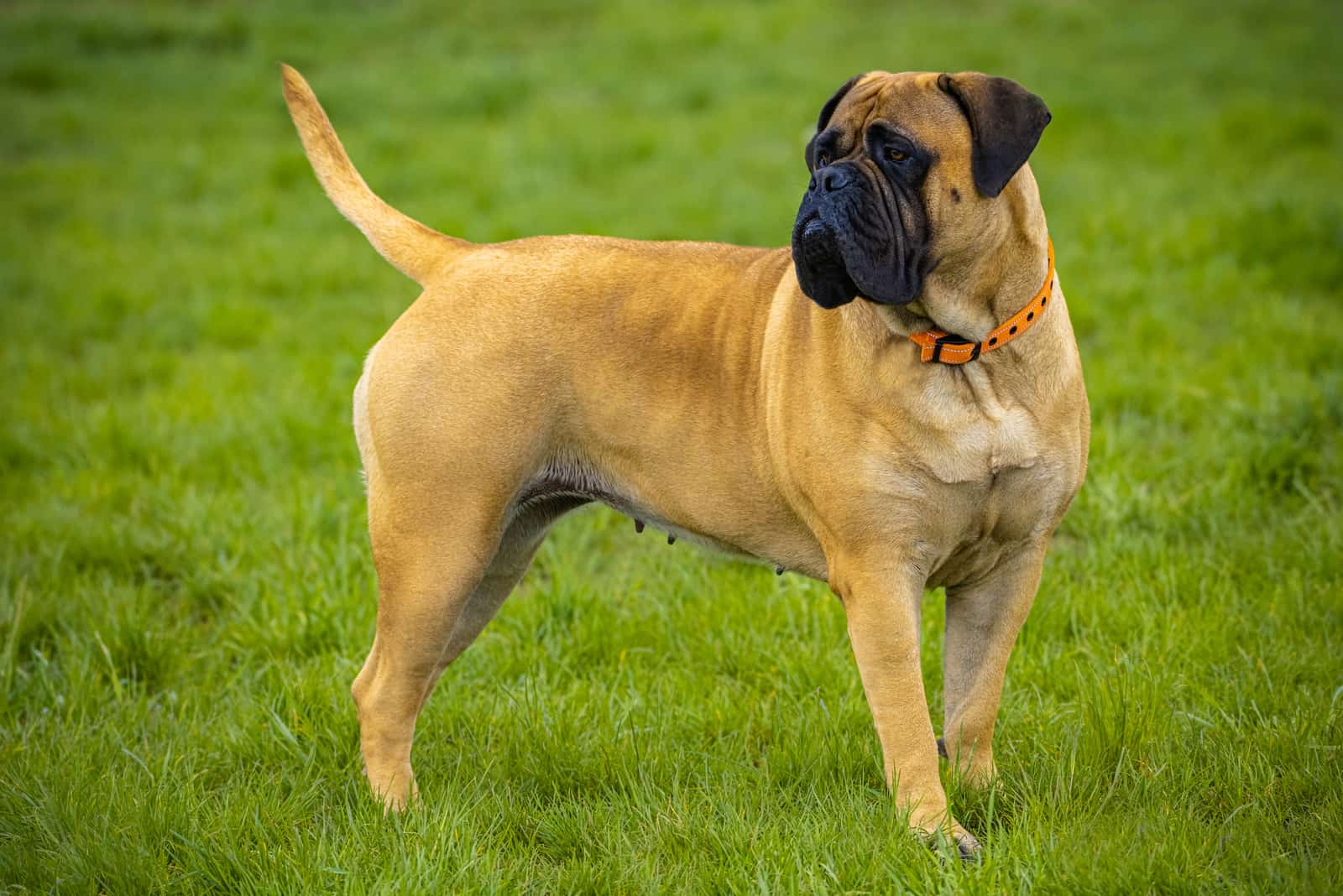
This Mastiff breed comes from the United Kingdom and is a direct descendant of the Old English Bulldog and the Old English Mastiff (can’t be more English than that).
They are known as domestic canines, as their primary role was one of property guard dogs, although today, they are known as furry companions and lovely members of their human families.
Bullmastiffs might be a bit stubborn, but they’re generally easy to train, which is why they’re suitable for families, even those with small children.
The Bullmastiff shades and coat patterns usually include brindle, red, and fawn, which can be combined, so don’t be surprised if you see these pups in red or fawn brindle hues and markings.
However, be prepared for a lot of slobber around the house, as these canines have a great tendency to drool, especially when they see their favorite dog food.
Because Bullmastiffs are prone to a variety of health problems, it is essential to take them to the veterinarian at least once every six months.
15. Canary Mastiff (Perro de Presa Canario)
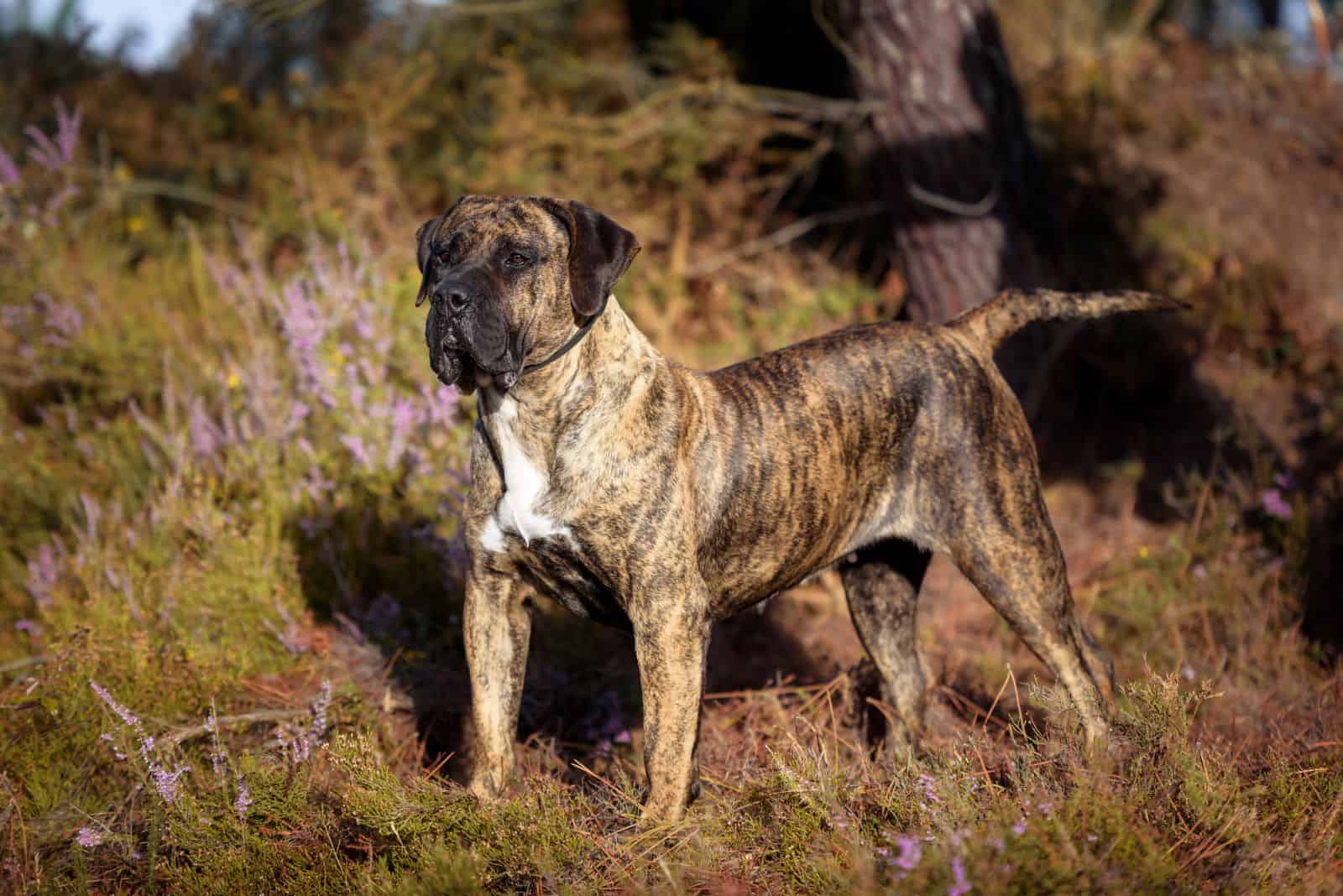
Large in stature, the Canary Mastiff, also known as the Perro de Presa Canario, has a physique that is stocky and muscular.
As a result of their hostility and physical strength, they were frequently employed in the ring as fighting canines.
Presa Canarios are found in shades such as black, fawn, brindle, silver fawn, red fawn, and red brindle shades and markings.
This canine requires training, including socialization and obedience, from early puppyhood, otherwise they might be tough to deal with when they grow older.
Their aggressiveness is manifested towards strangers and other canines that they’re not accustomed to.
This Mastiff breed demands regular activity in order to maintain its sturdy physical appearance. The canine takes pleasure in a variety of different types of outdoor and indoor physical exercise, ranging from simple strolls through games and agility practice.
Because they have a higher risk of becoming obese, you should pay particularly close attention to the quality and quantity of food they get.
16. Neapolitan Mastiff
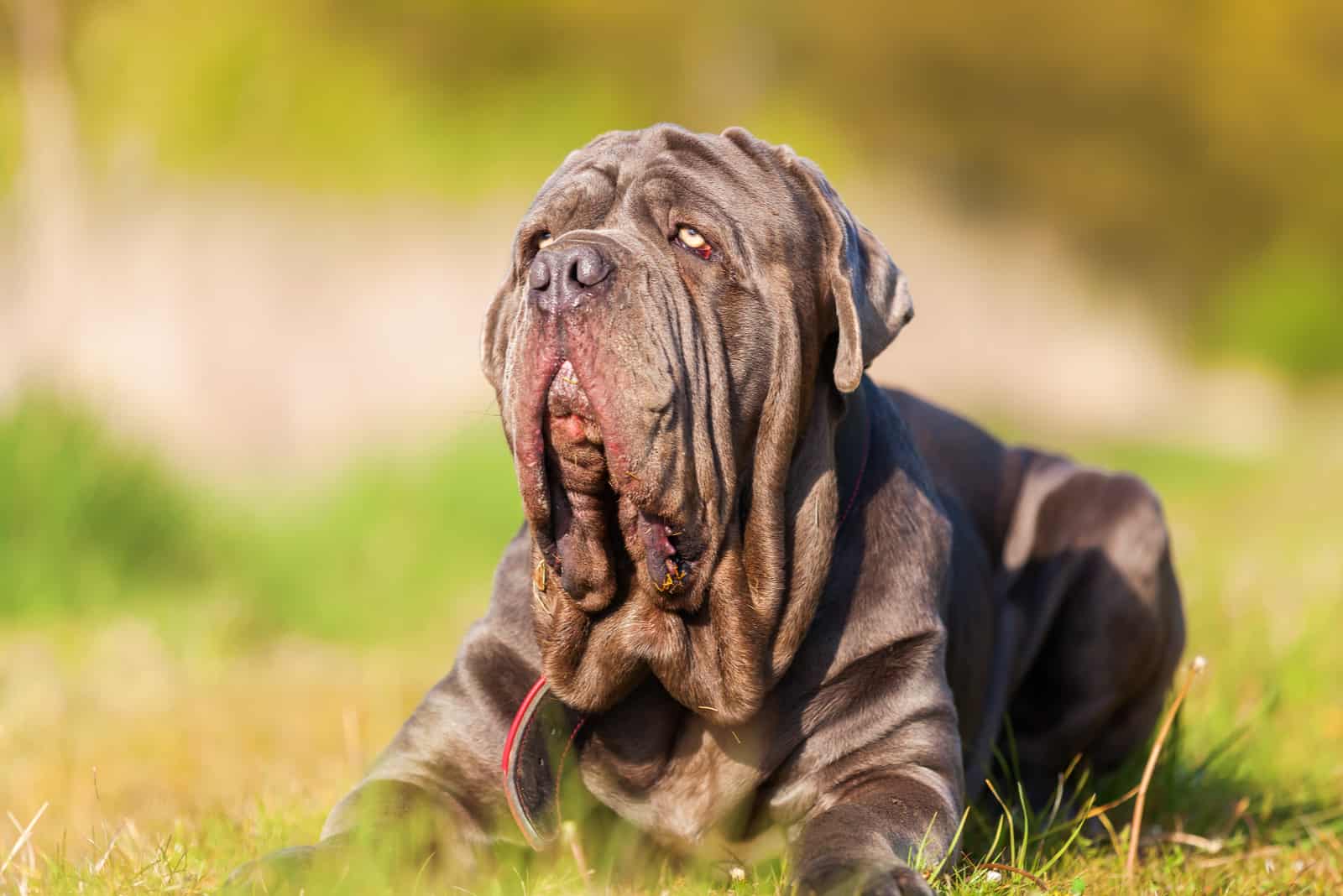
This type of pup can be called an Italian Molosso too because of their country of origin, which is Italy. These canines are devoted working dogs that have a powerful appearance, sturdy stature, and lots of wrinkles all over their faces.
When it comes to their fur, these pups are decorated with short coats covered in tawny, blue, black, brindle, and mahogany hues.
These canines are often related to Cane Corsos, which is no surprise, considering that they both come from the same parent breeds – molossus canines (Epirus Mastiffs), which were crossed with other canine breeds in Italy.
It is a bold, loyal, and extremely powerful dog that will protect its owners by any means. They are always prepared to react when they sense any kind of threat.
This particular kind of Mastiff is exceptionally bright, picks up new skills quickly, and is simple to train. It is essential to socialize them appropriately to prevent them from being hostile toward people they do not know.
RELATED: Neapolitan Mastiff Breeders: 8 Tastes Of Italy
17. Brazilian Mastiff
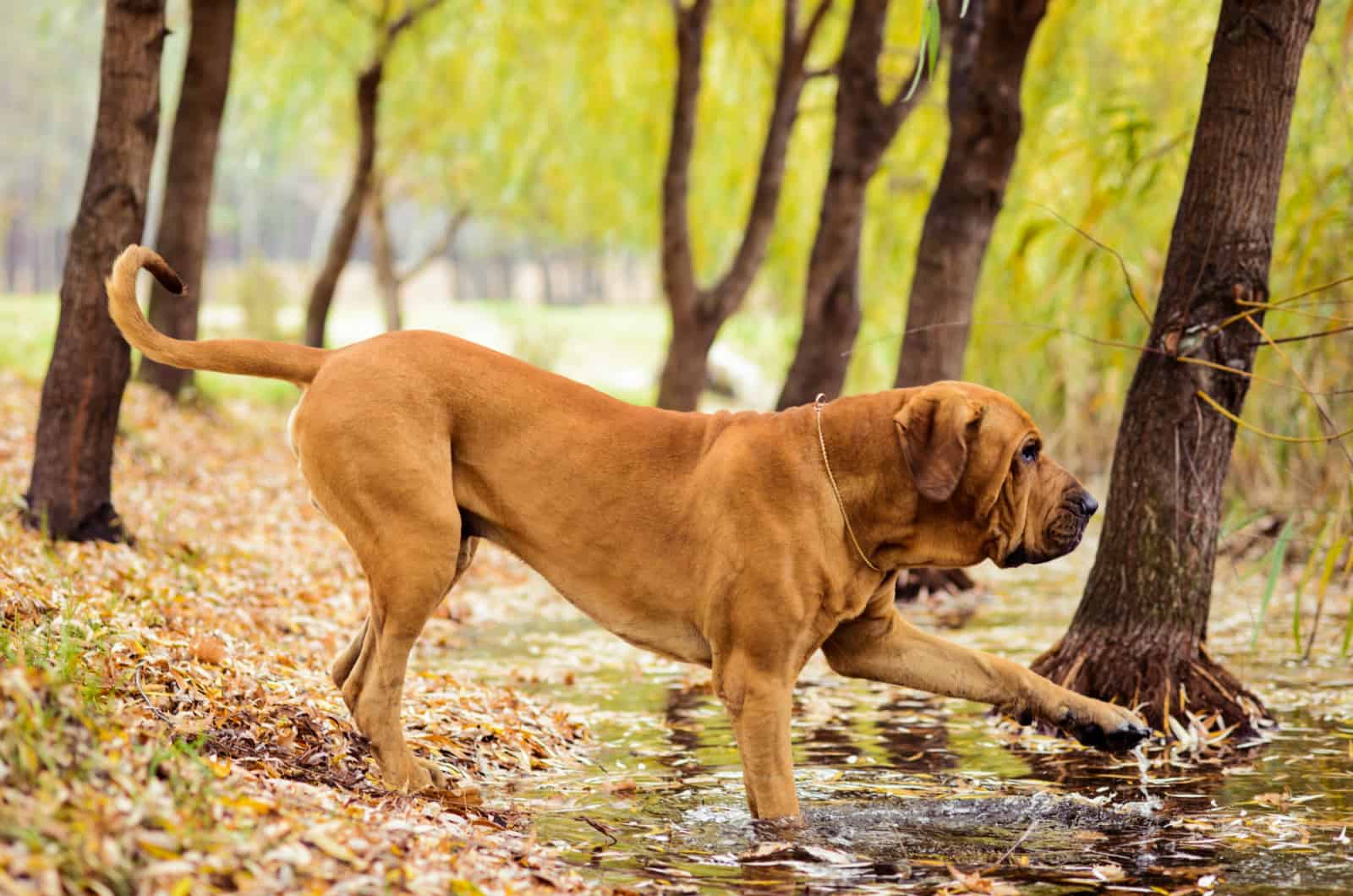
Fila Brasileiro, or the Brazilian Mastiff, looks quite similar to other Mastiff breeds as they all possess certain characteristics related to their physical appearance, such as the wrinkles and folds on and around their heads.
They are considered one of the best Mastiff breeds when it comes to hunting, as they have strong prey drive and agility, which enables them to catch and hold any prey.
Their need to guard is so strong that even early attempts at socialization will have little effect on their behavior. Having said that, they are not a good match for the majority of families.
They are highly distrustful of people or animals they’re not familiar with, to the point that they might even show physical aggression.
The coat of the Brazilian Mastiff is characteristic because of the white ring, which appears on a black, brindle, or fawn background.
18. Gaddi Kutta
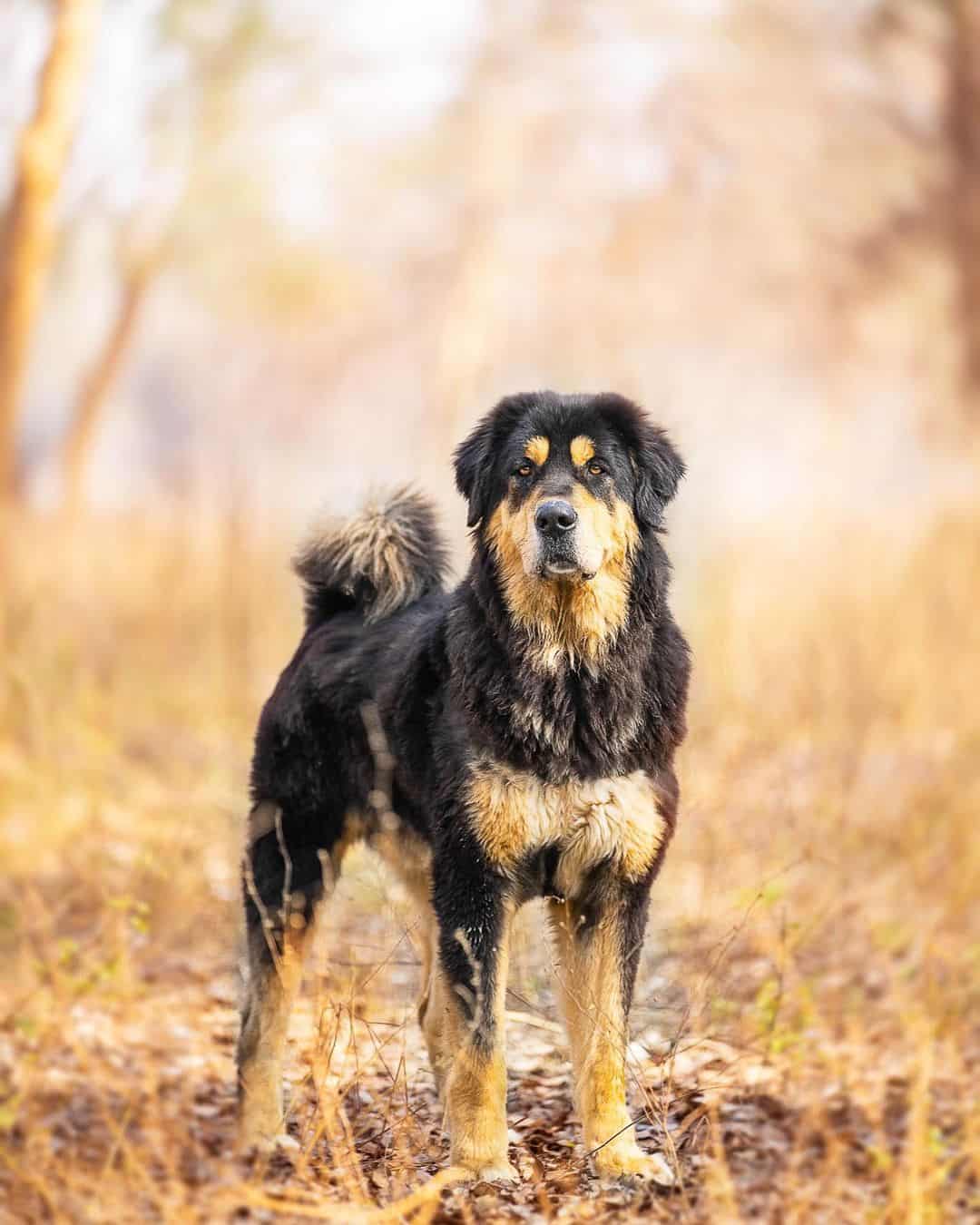
Photo from: @pragalbhvashishth
This isn’t just one of the best Mastiff breeds but also one of the Mastiffs with one of the most unusual names. Another name for these canines is Himalayan Sheepdog, but some owners might even call them Himalayan Mastiffs.
It is believed that they’re related to Tibetan Mastiffs, with which they share certain personality traits such as boldness and territorial instincts.
These canines have double coats, which causes moderate to high shedding, especially during spring and autumn. This type of coat kept them protected from severe climate conditions in the Indian mountain regions.
Gaddi Kutta can grow up to 34 in, which is why they’re considered one of the tallest dog breeds in the world.
They have great herdings kills, accompanied by fearless and calm personalities, which is why they were one of the preferred choices for herding dogs of Himalayan shepherds.
19. Japanese Mastiff (Tosa Inu)
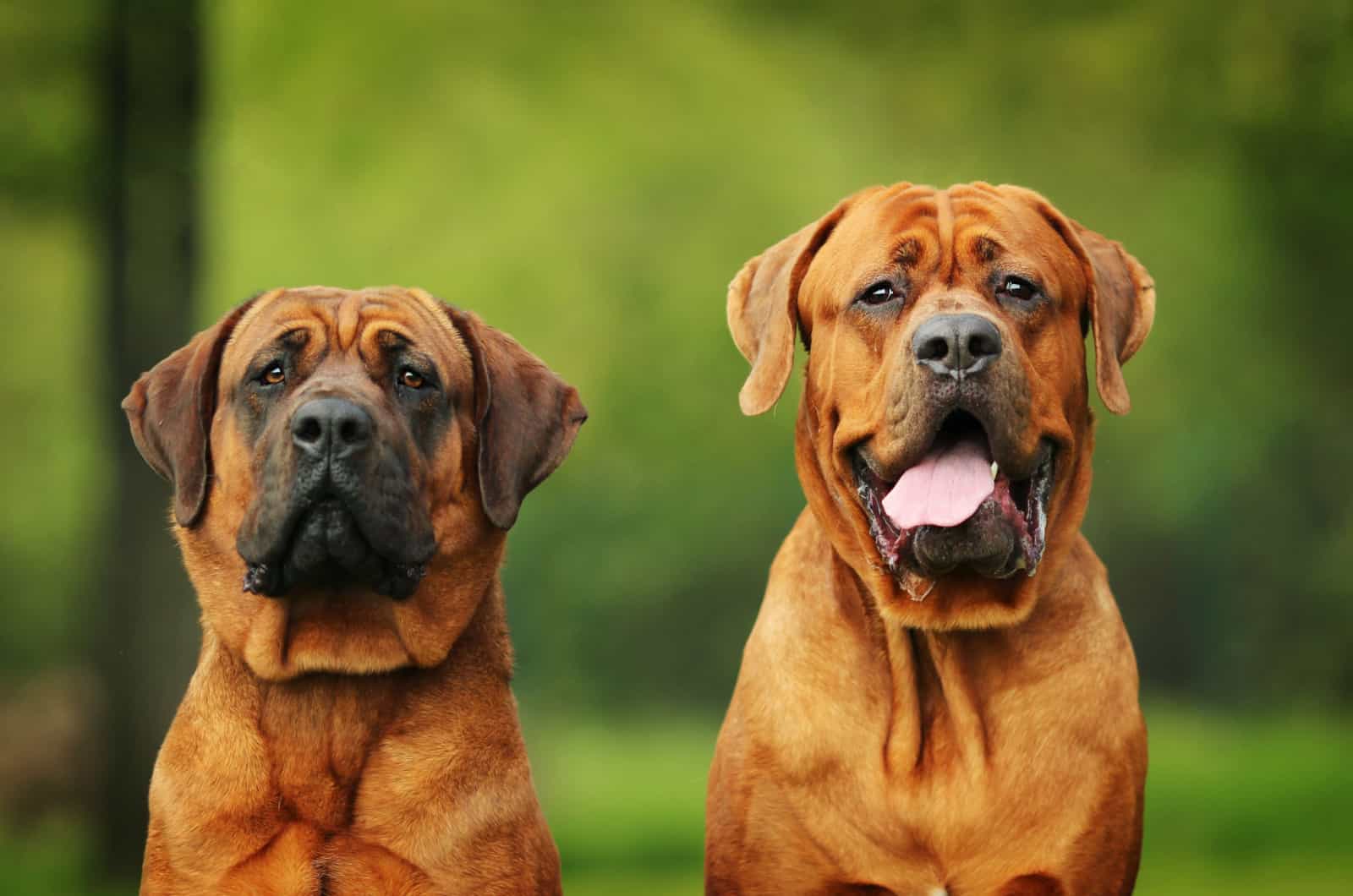
Japanese Mastiffs, which are also known as Tosa Inus, are a Mastiff breed that comes from Japan.
One of the most interesting things about this canine breed is that they’re not allowed in a certain number of countries, including Malaysia, the United Kingdom, Norway, Denmark, Germany, and Australia, because of the hostility and physical aggressiveness that they have shown in the past.
One of the main reasons why these pups are still popular in Japan is because they’re still being used as fighting canines, as this cruel practice still isn’t banned in this country.
Their appearance is characterized by small, upright ears, hazel-like eyes and strong jaws, along with a big dark muzzle that contains wrinkles and folds.
These pups don’t possess negative sides only; they have quite a lot of qualities as well, which include high intelligence, a fearless attitude, and obedience towards their owners, especially if they’re trained from the early days of their lives.
20. Sarabi Mastiff
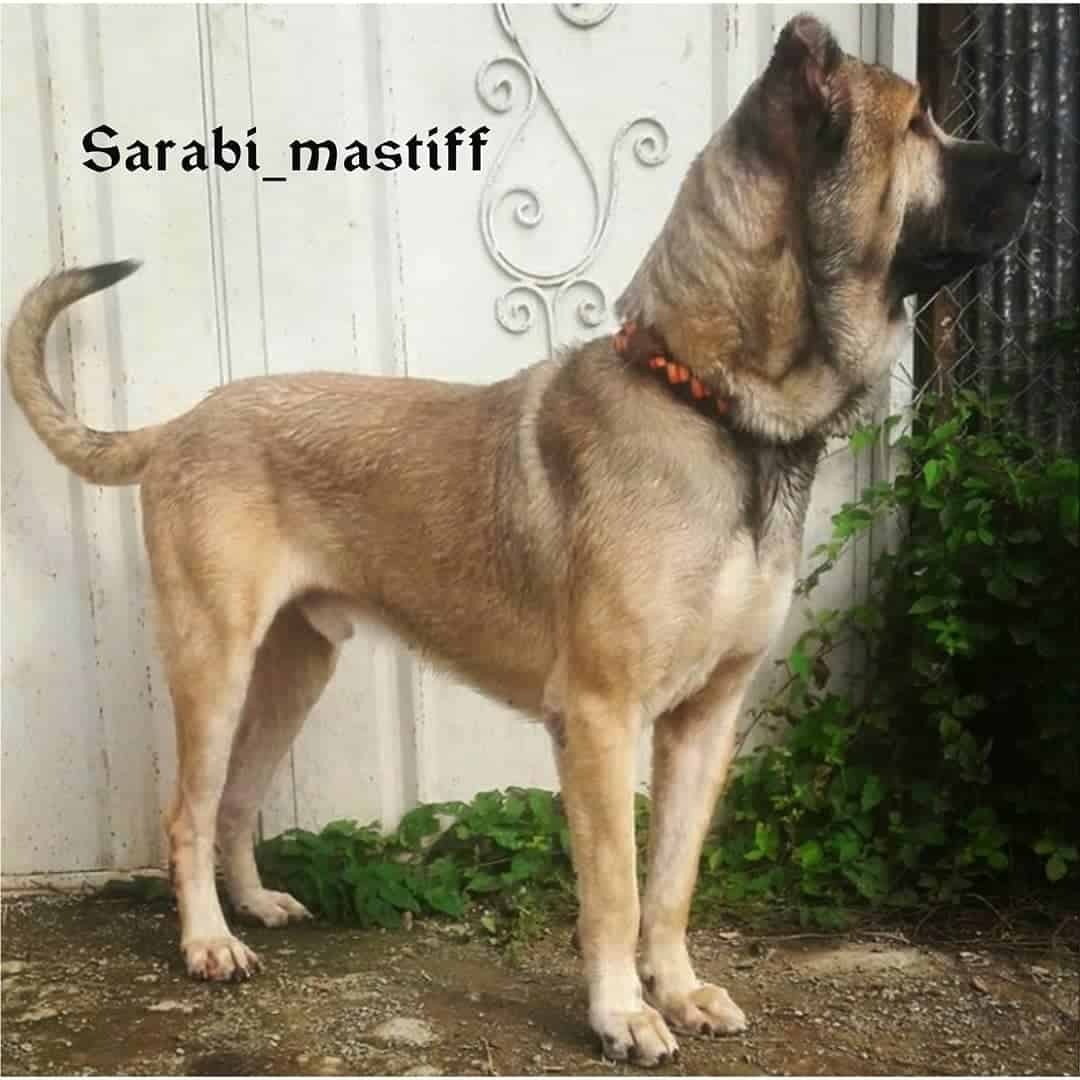
Photo from: @sarabi_mastiff
As you could have noticed so far, most of the Mastiffs are named after the countries or regions that they come from. The same goes for the Sarabi Mastiff, the dog breed that is named after a province in Iran.
They are able to provide excellent protection for cattle because of their muscular build and thick bone structure.
When it comes to members of the family, despite their tough looks, Sarabi Mastiff may be just as affectionate and friendly as any other dog.
These canines are characterized by short to medium coat lengths that can be colored in black or brown shades, which go well with their bright brownish eyes and dark-shaded muzzle.
They have high energy levels, which is why Sarabi Mastiffs require a lot of training and exercise during the day.
If you decide to get this pup, be prepared to pay full attention to them as they might easily turn to destructive behavior if they’re left alone in the house for a long period.
21. Argentinian Mastiff (Dogo Argentino)
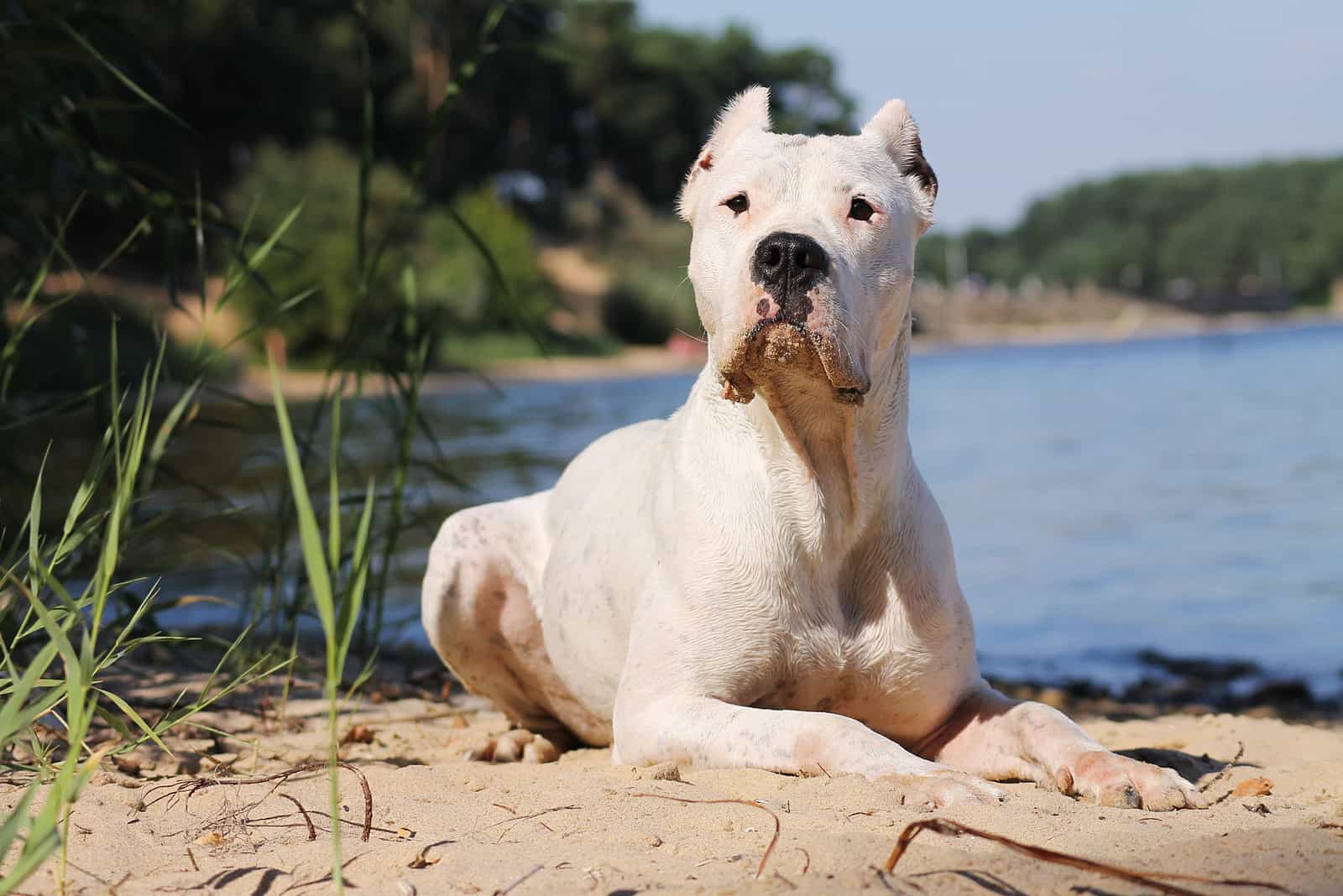
Dogo Argentino is a type of Mastiff breed with Argentinian roots that has the Cordoba Fighting Dog as one of its ancestors.
This canine is great for hunting big animals because of its size and muscle mass, which allows it to easily dominate even the most hostile boars.
However, even though they possess great strength and powerful appearance, these canines can be great family pets because they have the ability to turn into loving and affectionate pups as soon as they end with hunting adventures.
They place a high priority on autonomy, yet they are receptive to constructive guidance.
However, they consider smaller animals to be prey unless they are trained from a young age onward.
Dogo Argentino gets compared to Cane Corsos a lot. Although they don’t possess the same qualities, they do belong to the same type of Mastiff breed.
The main shade of the Argentinian Mastiff is white, although a smaller speckle of darker shade might be noticed in a certain part of their heads.
22. Alangu Mastiff
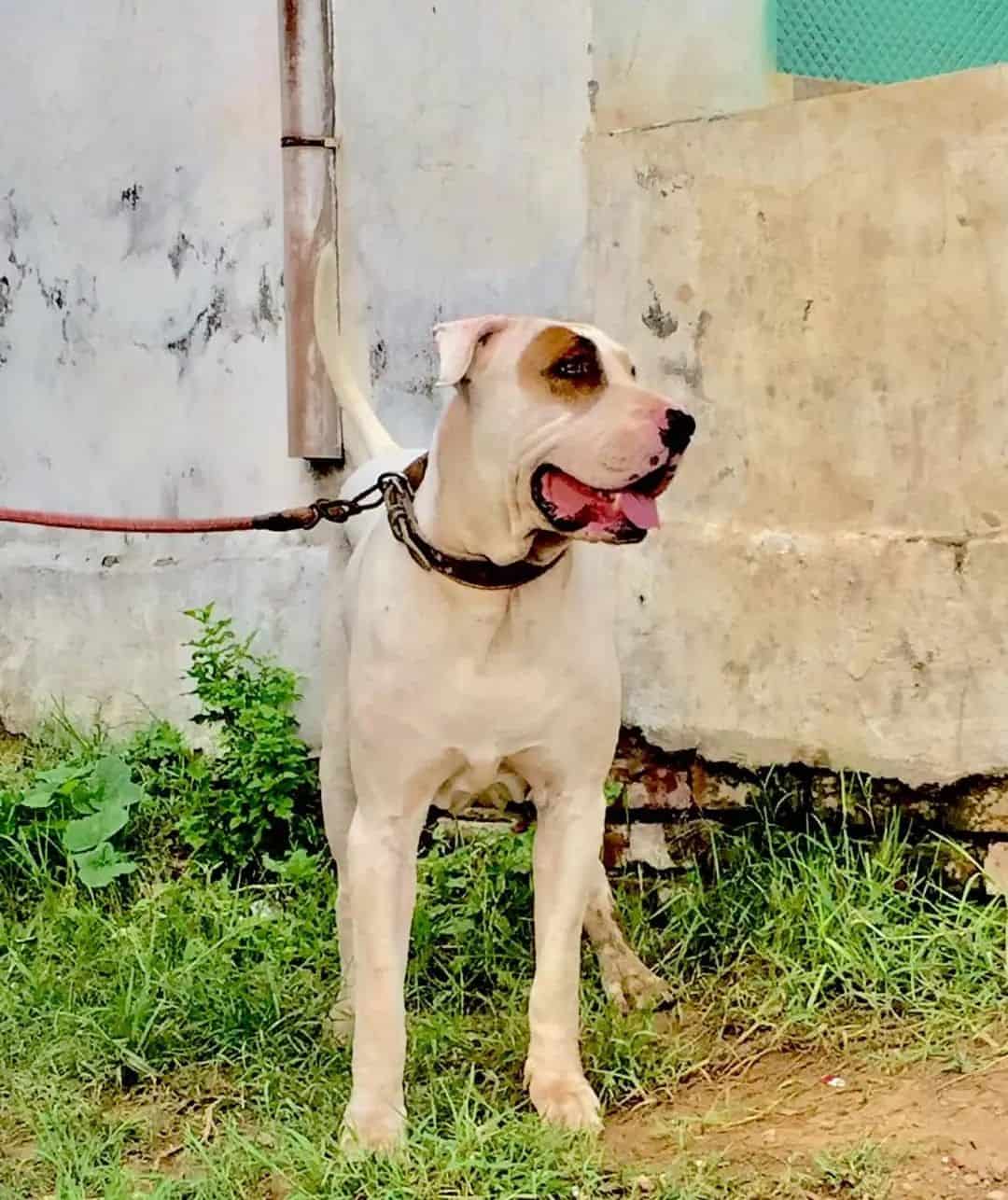
Photo from: @beast.bullykutta
This is another type of Indian Mastiff dog breed that is also called Bully Kutta, especially in their homeland area. These canines are agile, sturdy, and powerful, which is why they’re excellent watchdogs.
Due to their tendency to show hostile behavior, they are not suggested for people who don’t have prior experience in owning strong-willed canines like Mastiffs.
However, with proper training, these pups can become obedient to their dog owners, so they shouldn’t be completely written off as family dogs.
When it comes to its coat, this type of Mastiff canine doesn’t require much grooming as it has a rather short fur that is covered with brindle, fawn, or red shades.
Although Alangu Mastiffs are relatively healthy, these dogs can develop certain health issues like arthritis or visual impairment throughout time, especially in their senior years.
23. South African Mastiff (Boerboel)
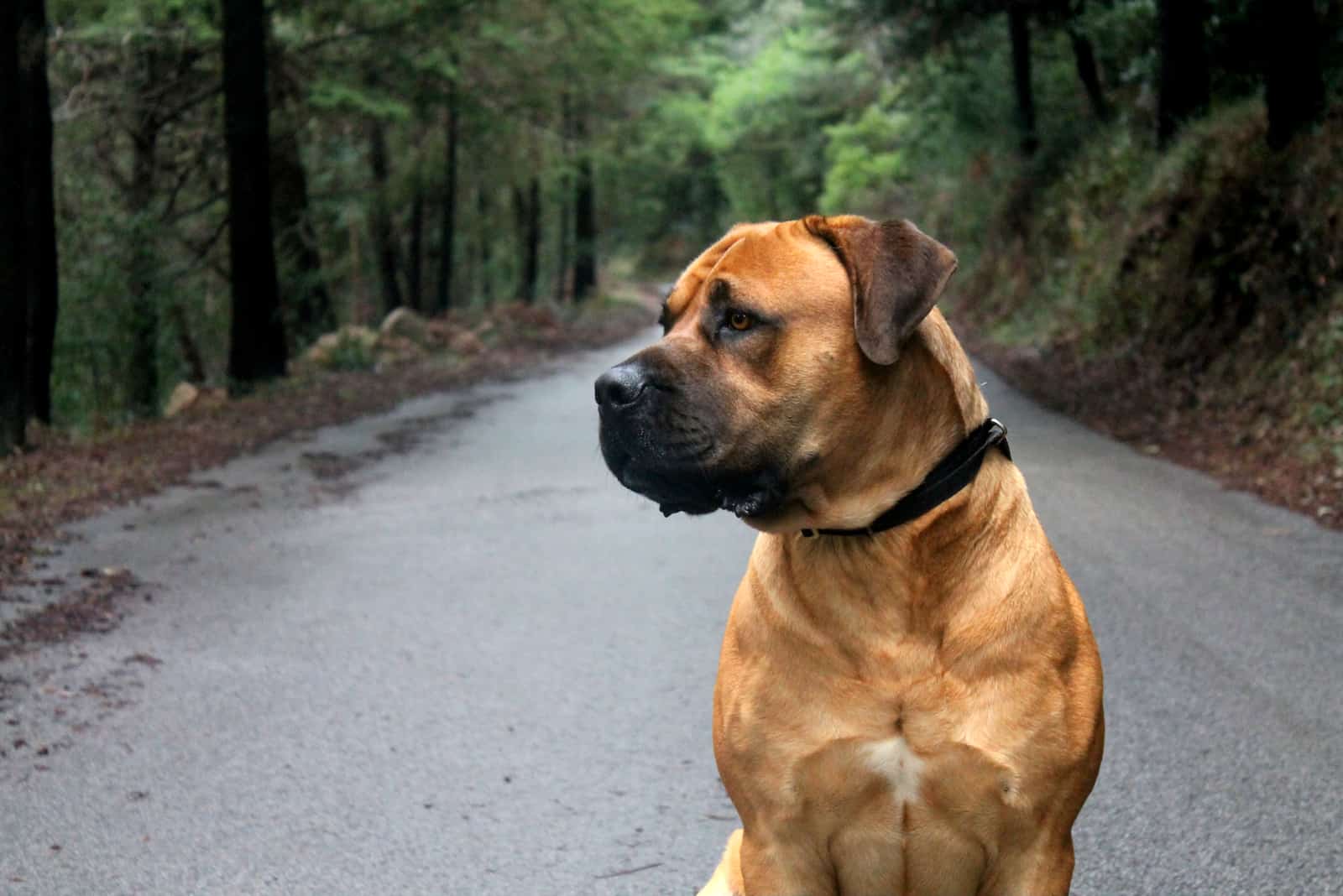
Boerboels, a breed of dog that comes from South Africa, is one of the popular Mastiff breeds that was acknowledged by the American Kennel Club (AKC) in 2015.
These canines are exceptionally self-assured, steady, and peaceful, which is why they’re one of the most popular choices for pets, not only in South Africa but in other regions as well.
Purebred Boerboels have very strong jaws, probably the strongest ones of all breeds, as they’re believed to have the most powerful bite. Moreover, there are many Boerboel mixes that inherit such sturdy bone structure from the purebred Boerboel parent.
According to the breed standard, Boerboels usually grow up to 27 in and weigh up to an impressive 200 lbs.
When it comes to their coats, they usually have shorter fur that is colored in red, tawny, brown, reddish brown, cream, and brindle hues.
These pups are very smart and calm, but they’re also completely loyal to their dog owners. They get strongly attached to the family that they’re a part of, so be prepared for a canine who’ll probably even sleep right next to you.
24. Saint Bernard
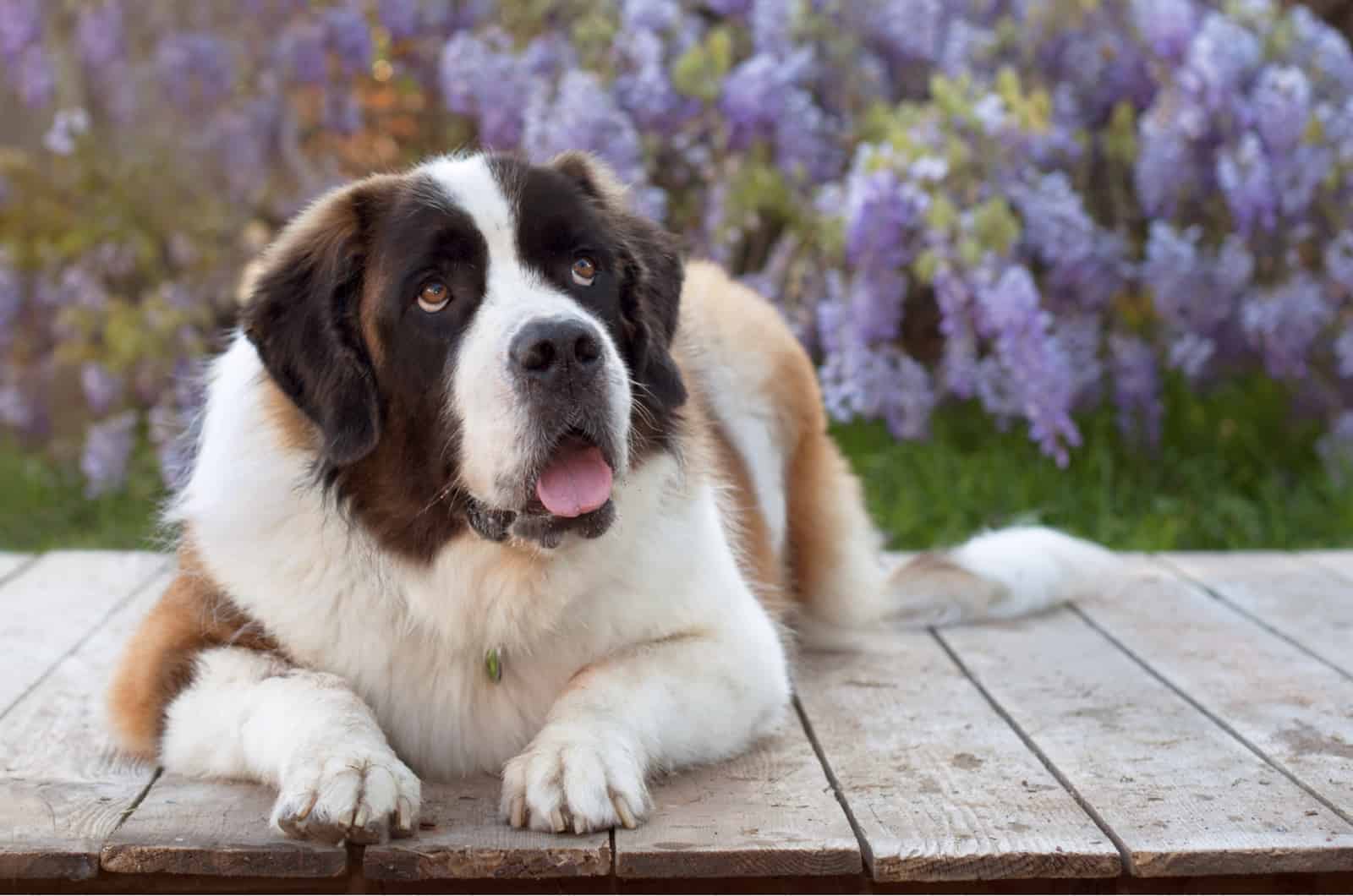
These canines are very popular among dog breeds, but not many people know that they are also a type of Mastiff breed.
Swiss Alps was their original residence, although they’ve been a popular choice for a family pet around the world for a long time.
Because of their massive, thick coat, they are able to maintain their body temperature in extremely cold situations. However, this type of coat makes them quite difficult to groom, as they shed immensely throughout the year.
The main shades of the Saint Bernard coats are brindle, mahogany, orange, rust, red, brown, and an apricot-like hue that are all combined with white color (either as a marking or background shade).
These pups usually grow up to 30 in and weigh anywhere from 140 to 180 lbs.
They have an excellent sense of smell, which enables them to be useful in the search for lost humans or animals.
Saint Bernards are also known for their incredible amount of tolerance and their compassionate nature when it comes to children, which is one of the main reasons why they’re considered great family canines.
25. Anatolian Mastiff
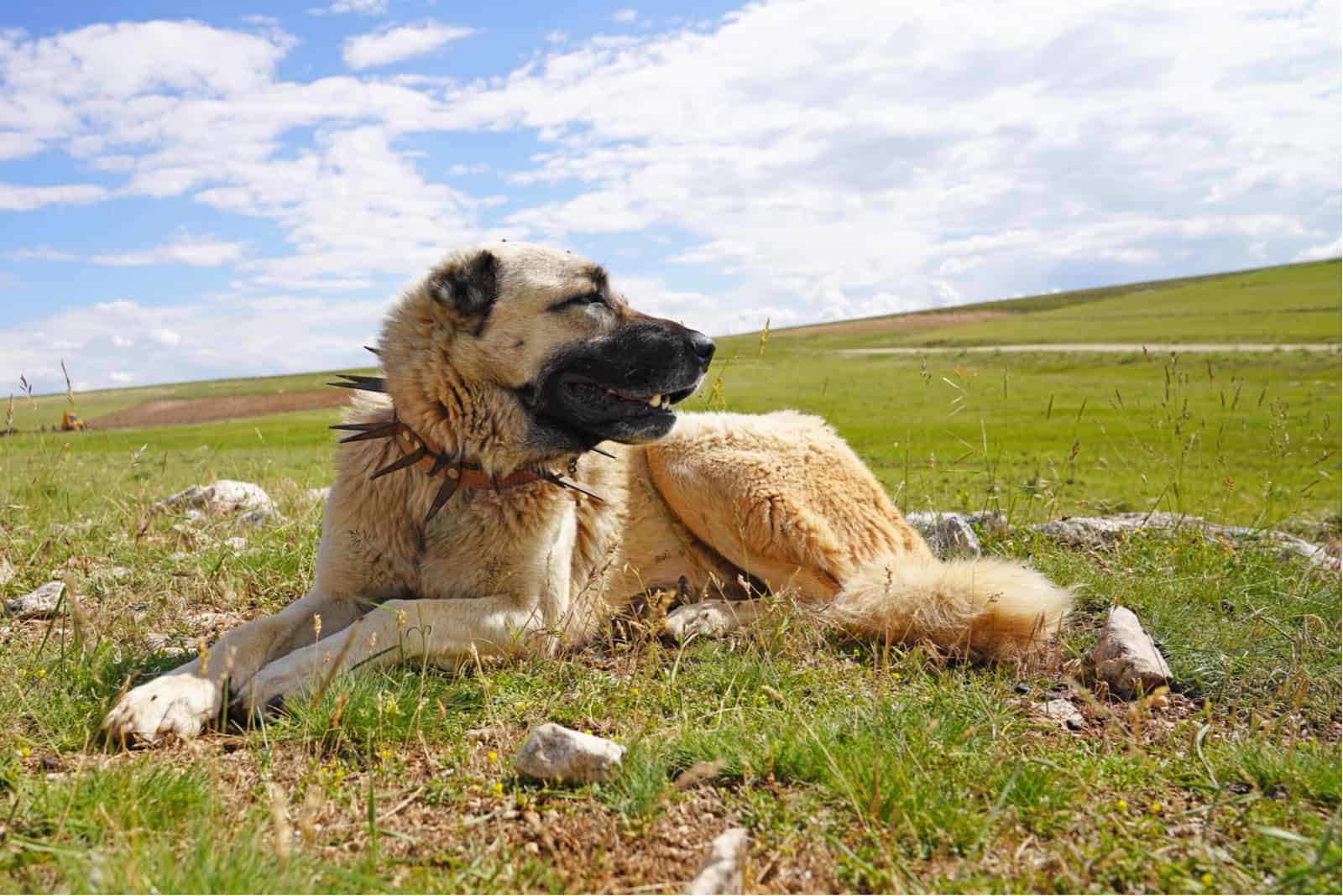
Anatolian Shepherd Dog and Kangal are two other names for this powerful type of canine that have been utilized as working canines for a long period throughout history.
READ NEXT: 5 Top Kangal Breeders: Anatolian Shepherd Breeders In The U.S.
Their main role was one of the sheep guardians. The protective nature and property guarding skills are some of the main reasons why they’re considered the best dogs for sheep herding.
They’re a dominant and independent canine breed that knows how to take care of its protectees without any aid from the owner.
Although they can function on their own, Anatolian Mastiffs love to be a part of the family and will offer a lot of affection to all family members, not only their owners.
You can expect your Anatolian Mastiff puppy to reach a height of 29 inches in adult years and a weight of 150 pounds.
They come in several hues, including brindle, liver, white, blue fawn, white and biscuit, and red fawn.
RELATED: 15 Anatolian Shepherd Mixes That Will Truly Amaze You
26. Newfoundland
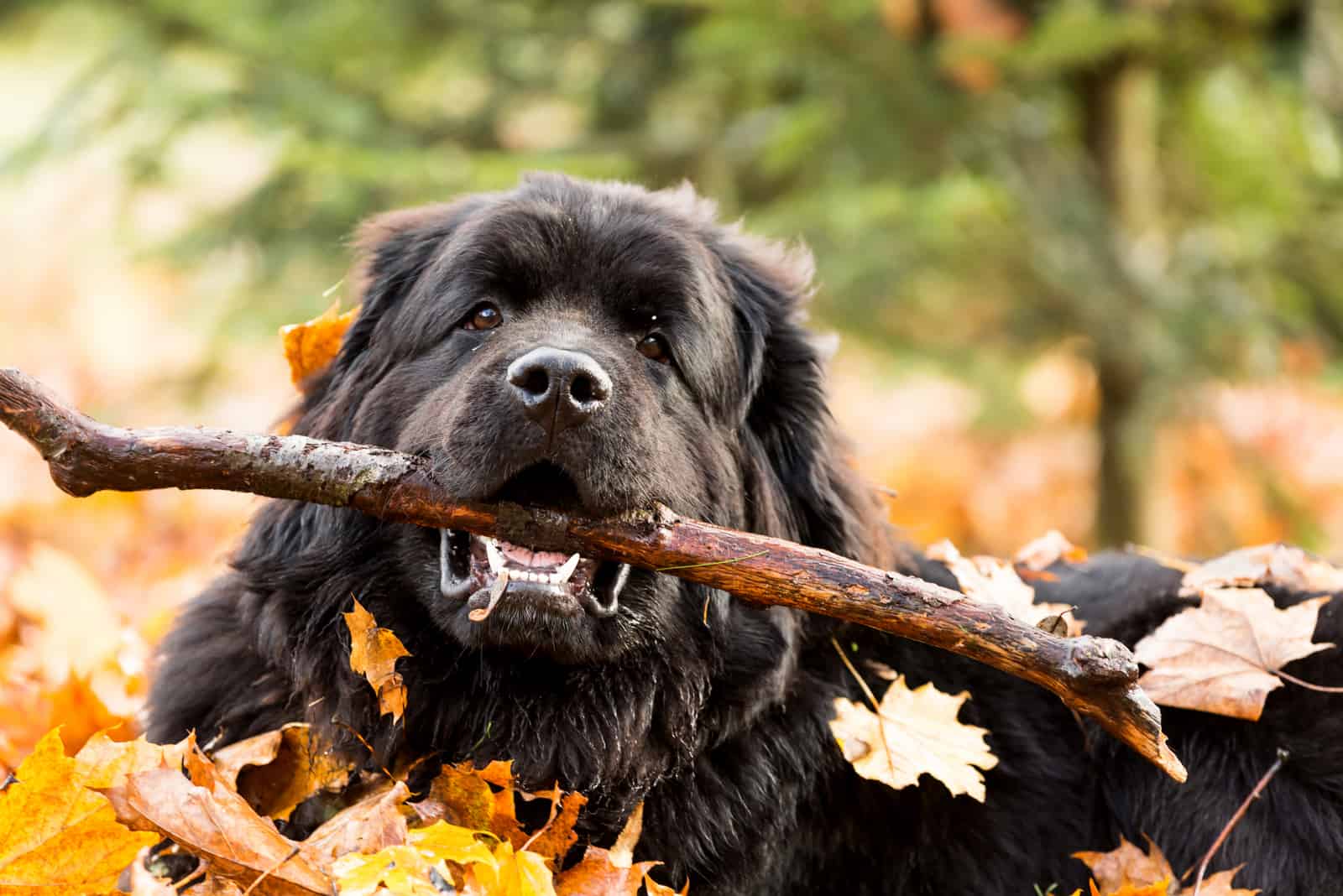
This is a type of Mastiff that has a large stature and even larger heart. They are highly-skilled dogs that were used to herd fish in the past, but they have become lovely pets of families around the world.
Their homeland is Canada (Newfoundland, to be exact), but they’re becoming quite popular in the United States as well.
Many people believe that Newfoundland is the breed of dog that is the most powerful and the largest one overall.
Their weight can go up to 150lbs, and their height usually ranges from 27 to 29 in.
Although they’re affectionate and loyal to their dog owners, they still require early socialization and obedience training to make sure that you have a well-mannered furry buddy.
Considering that they have thick coats, you can expect these pups to shed quite a lot, which is why they require daily grooming sessions.
27. Bernese Mountain Dog
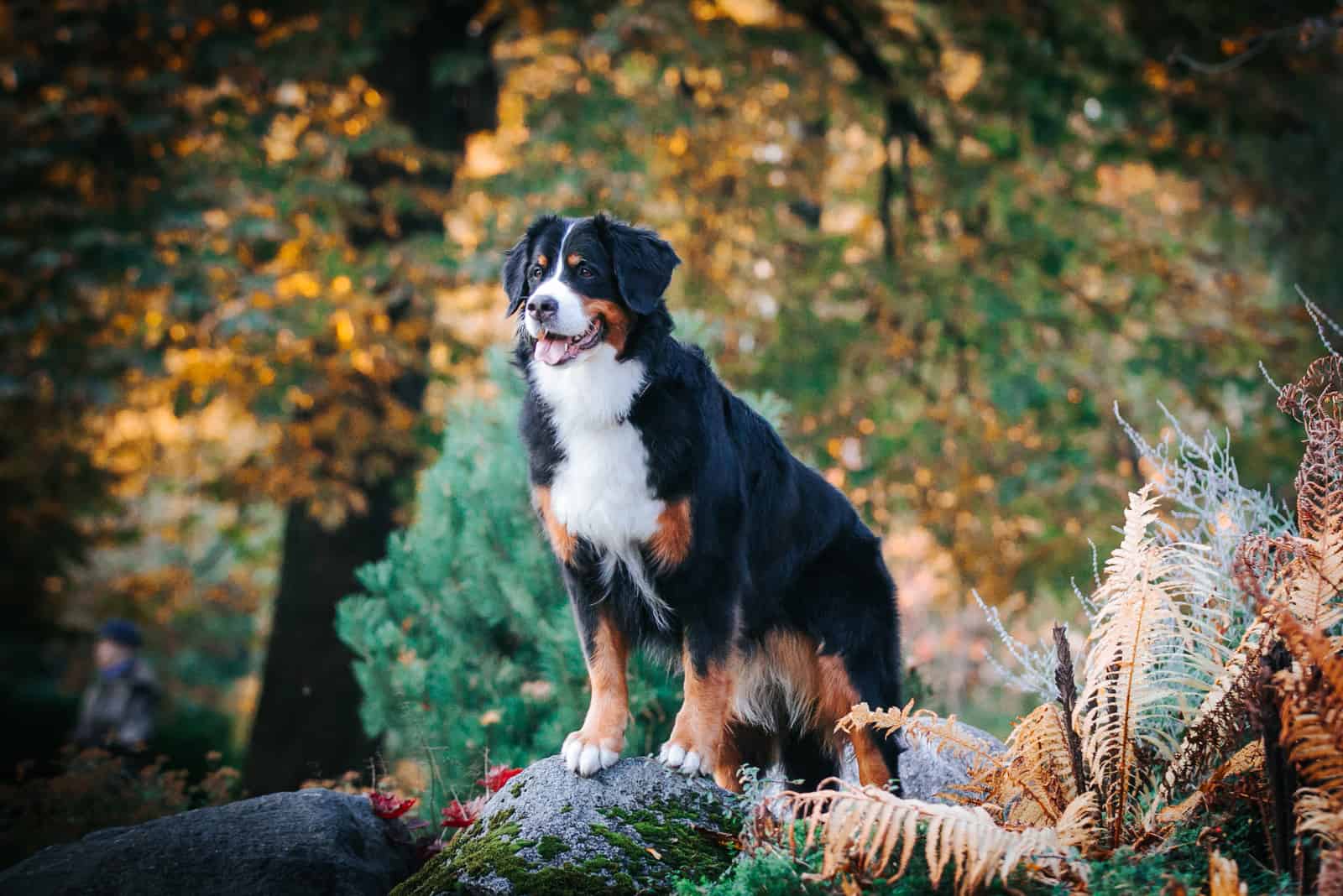
These canines are considered Mastiff dogs because they originate from the Roman Mastiffs, which were an ancient breed of dogs.
However, this isn’t the only category that they belong to. Bernese are also known as the Sennenhund types of canines which came from the Swiss Alps.
They are working dogs that are large, robust, and ready for action, but on the other hand, they do like to relax on a couch near their owners as well.
Bernese are characterized by a solid temperament and friendly attitude that helps them interact with kids and other animals more easily.
Their coats are usually of medium length. The fur shades of purebred Bernese canines can be white, rust (or red), and black, combined in a tricolor pattern in order to comply with the AKC’s breed standard.
They are moderately high, as Bernese usually grow up to 27 in, but they’re also incredibly strong.
28. Mountain Mastiff
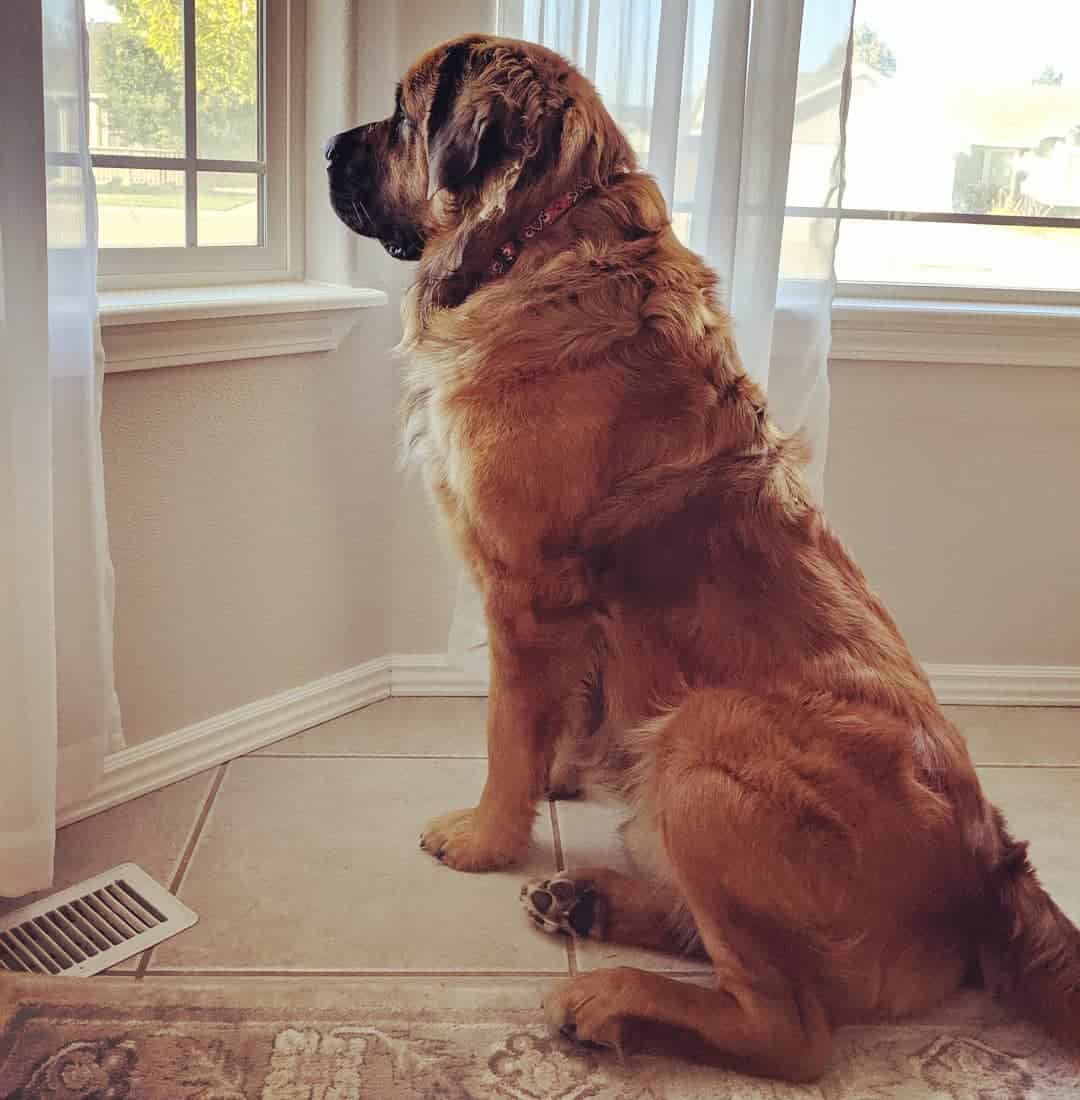
Photo from: @duke_the_mountain
Even though this is a Mastiff breed dog, it’s not a purebred canine, as it’s the result of crossing between Mastiff and Bernese Mountain Dog.
However, it’s important to mention that as a designer dog breed, this crossbreed is getting only the best traits of both parent breeds, including health, physical appearance, and temperament.
Although their looks do remind of Mastiff canines a lot, especially when it comes to their height and weight, these pups are much more open and kind towards other people and animals.
They’re lovable and eager to please, but on the other hand, these pups do know how to keep their family members safe, as they possess great protective skills.
When it comes to their size, these doggies can grow anywhere from 28 and 38 in and weigh up to 200 lb.
They are known as great shedders, as they might shed even more than Golden Retrievers, Labradors, GSDs, Huskies, and others.
29. Danish Mastiff (Broholmer)
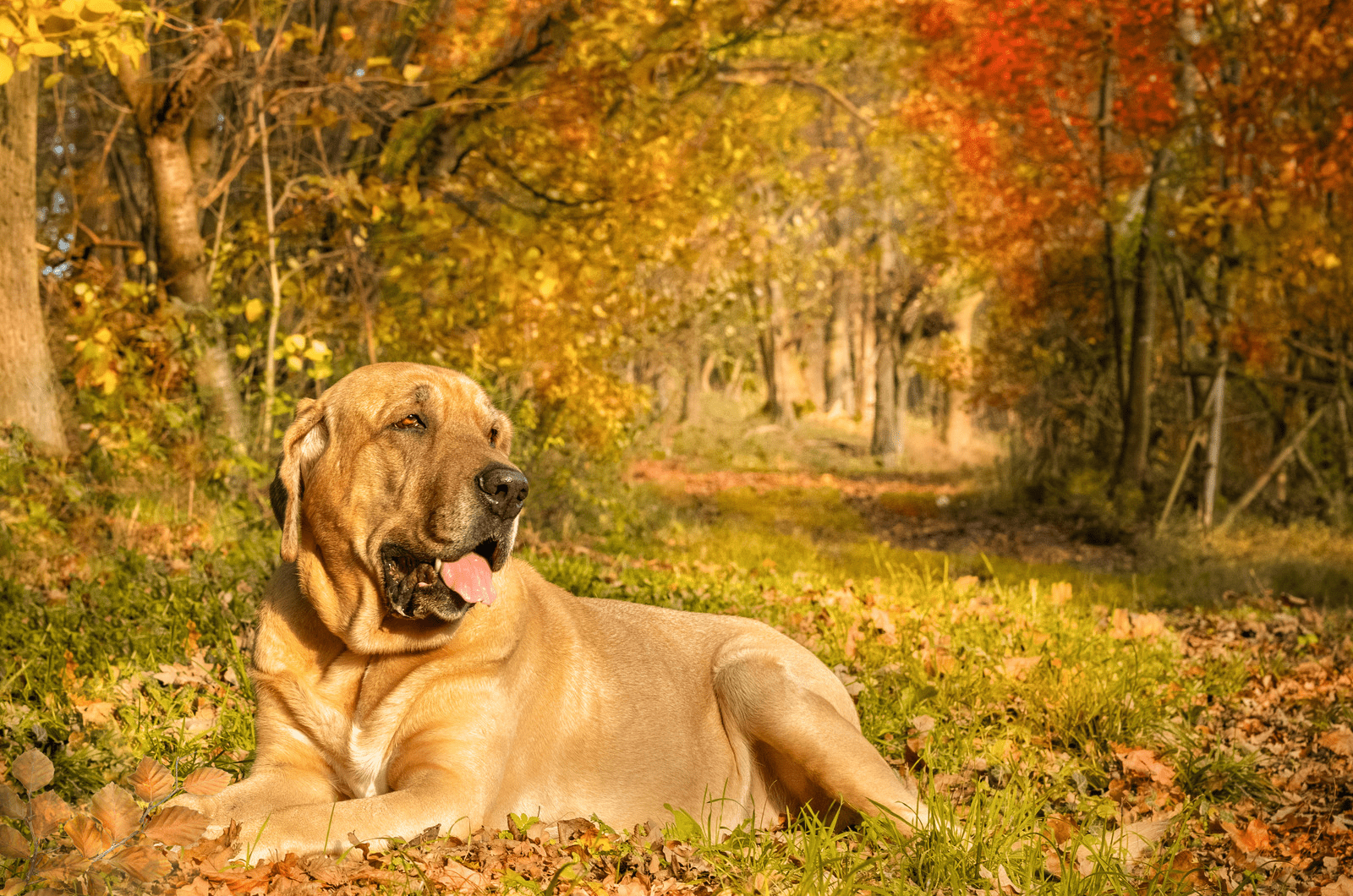
This is one of the lesser-known Mastiff breeds, which resembles other Mastiff canines quite a lot, especially when it comes to their physical appearance.
Danish Mastiffs have been recognized by the Fédération Cynologique Internationale (FCI) and the Danish Kennel Club, although you can find information about it on AKC’s official website.
However, AKC has not yet issued the breed standard for this type of canine, mostly because they’re still an uncommon breed in the United States.
These pups are mostly popular in Denmark and other European countries. This breed was introduced to the U.S. in 2009 when the first representative of Broholmers entered the States.
Danish Mastiffs are amazing family pets because of their calm nature and playfulness. However, they still keep an eye on their owners and families and know how to protect them if needed.
They usually grow up to 29 inches, but 30-inch Broholmers won’t be considered faulty either.
Their coats are short and colored in yellow, black, or red golden hues.
What’s The Best Type Of Mastiff?
Every Mastiff-type canine offers great qualities, so it’s not easy to choose the best out of all these great doggies.
However, if we speak about the best Mastiff breeds for families and dog owners who don’t have much experience with owning such powerful canines, one of the best Mastiffs is the English Mastiff, for sure.
These pups are protective and obedient to their owners, and they’re generally good with children, so they won’t cause you much headache.
Other breeds that are considered great family pets are French Mastiffs, Great Dane, and Bullmastiffs, although I wouldn’t completely exclude other breeds either.
Different people have different needs, so essentially, the best Mastiff dog is the one that contains all qualities you’re looking for in a pet.
What Is The Best Mastiff Breed For First-Time Owners?
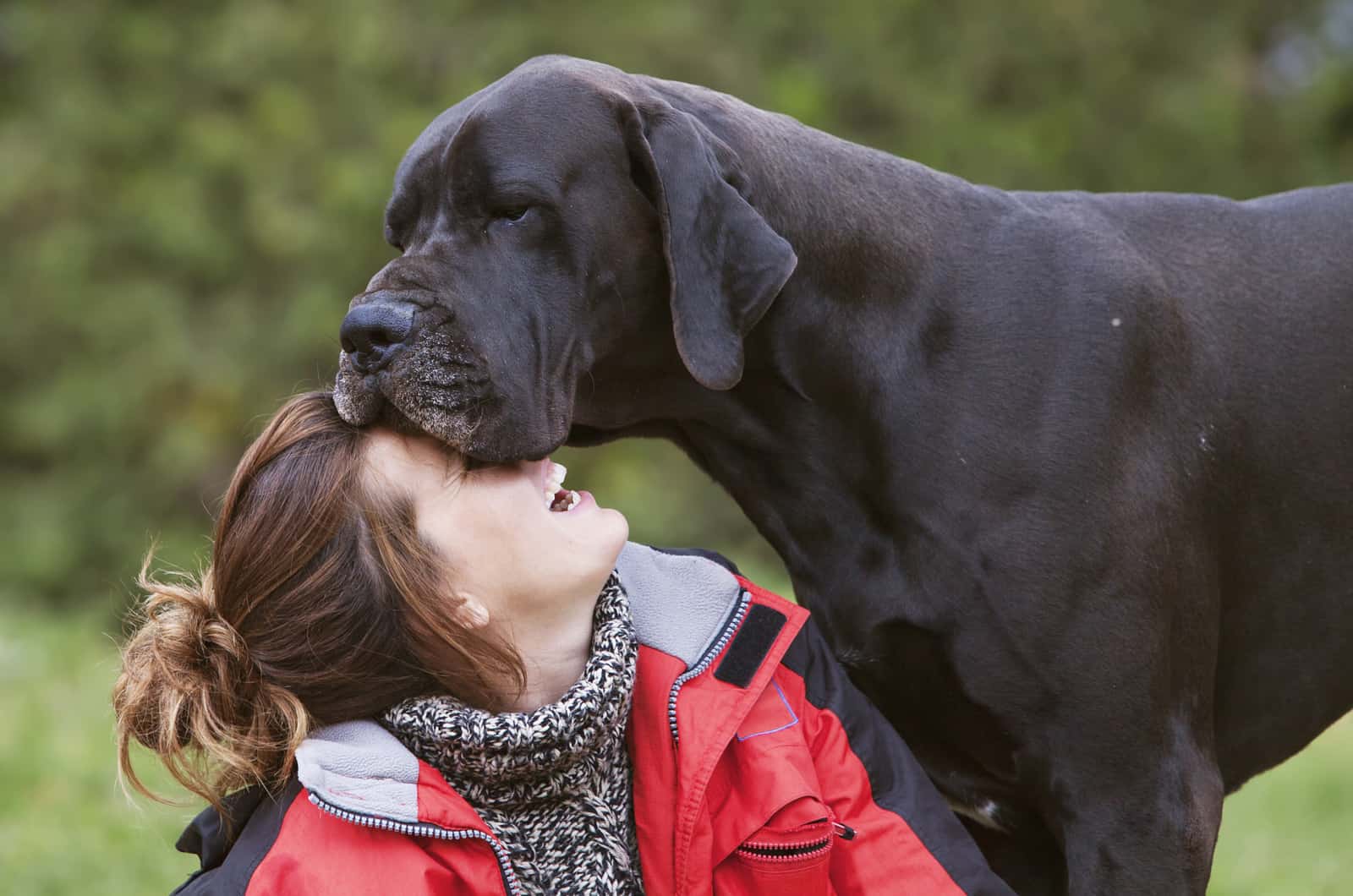
Although Mastiffs generally aren’t recommended for first-time owners, there are certain breeds that might be suitable if they’re properly trained from early puppyhood.
Some of the breeds that can be owned by inexperienced dog enthusiasts are Great Danes, Dogo Argentinos, Cane Corsos, Broholmers, and Presa Canarios.
Of course, other breeds can be trained to become good pets as well, but if you’re not sure how to successfully conduct training sessions with more strong-willed canines, it would be better to get them trained by a professional dog trainer.
What Are The Common Health Issues Of Mastiff Breeds?
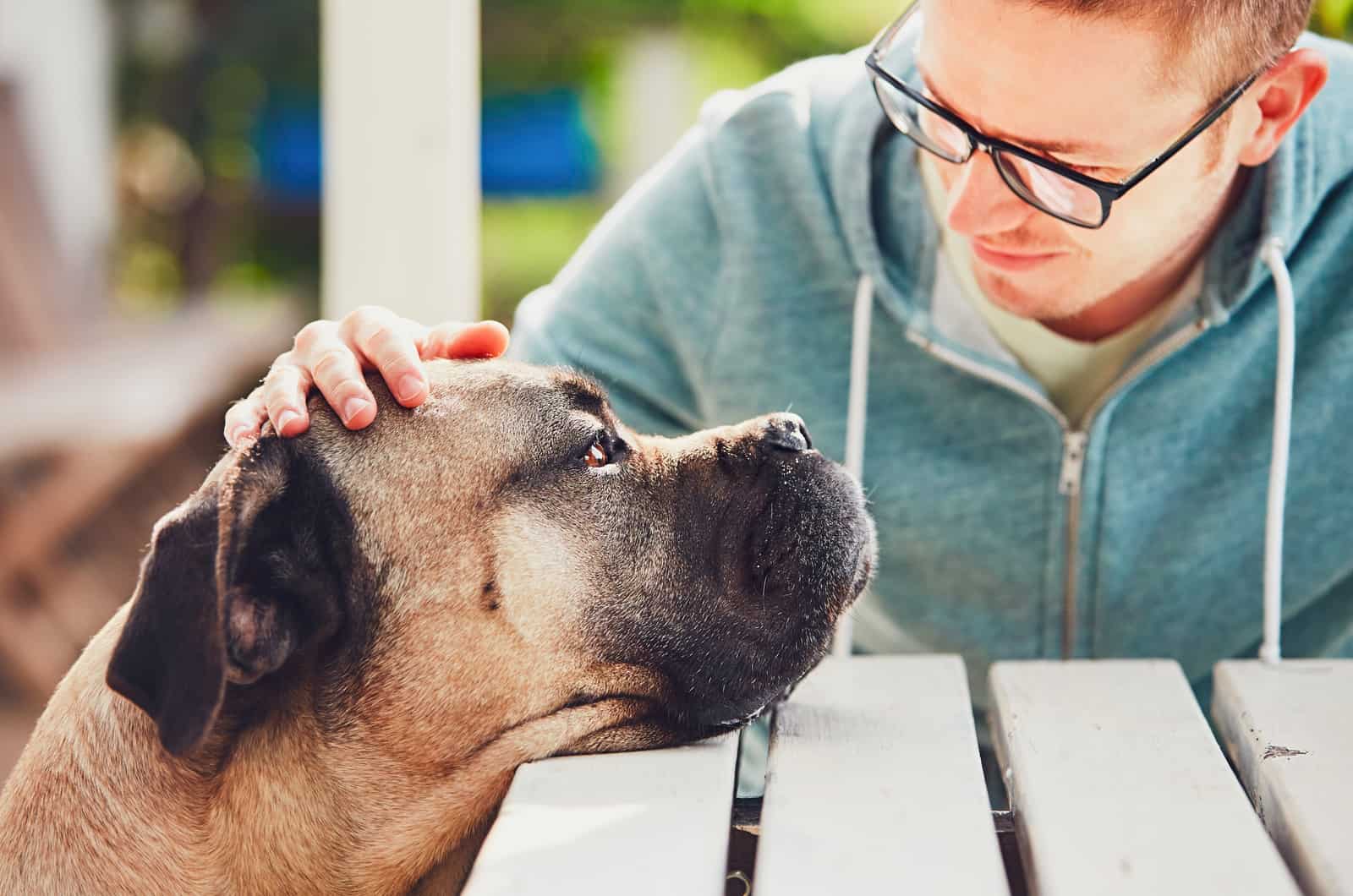
Although Mastiff breeds are considered generally healthy, mostly because of their powerful appearance, there are certain health issues that they’re prone to.
Keep in mind that the health issues from this list aren’t the only conditions that might occur in Mastiff dog breeds, as some of the health problems might not be related to the whole category of canines but to individual pups.
Health issues can be caused by genetics, age, weight, or as a side effect of another condition.
• Hip Dysplasia – This condition is present in almost every large dog breed, including Mastiff breeds, although it does occur occasionally in smaller types of canines as well.
This condition is characterized by the abnormal growth of certain parts of the hip socket. If the ball doesn’t follow the growth of the socket, the dog might end up limping for the rest of their lives.
Hip dysplasia is an inherited condition, but it might not immediately show in puppies. Actually, this health problem usually appears as the canines grow older.
Although it can’t be cured, there are certain treatments that might prolong more severe symptoms of this condition.
• Arthritis – It’s possible that your pup is experiencing a form of canine arthritis if it has trouble getting up or moving without falling down, as well as fatigue or stiffness.
The most common type of arthritis in large canines is Osteoarthritis, which affects almost every fifth mature canine in the United States.
The main cause of this health issue is the lack of a joint cushion, which causes the bones to come in direct contact, resulting in severe pain and inflammation.
Limping, loss of appetite, walk refusal, lethargy, and unusual behavior overall are some of the most common symptoms of this condition.
• Obesity – This condition has become one of the most common eating disorders in canines of almost every type, not only large pups.
Although owners try to do only the best for their pups, sometimes, we all tend to feed our pups more than we should, simply because we often mistake their love for food as a need that has to be fulfilled.
The most common symptoms of obesity are a round face, inability to feel the pup’s ribs, tiredness, stomach sags, refusal to play or go for a walk, etc.
• Osteosarcoma – This is a type of tumor that develops from the aberrant generation of cells that are responsible for both the formation and the destruction of the skeleton.
Osteosarcoma can also attack tissues that are not made of bone, such as glands, liver, and kidneys. This kind of disease is known as extraskeletal osteosarcoma.
It appears that this condition strikes large types of canines more frequently than smaller ones.
Mastiff breeds, Rottweilers, Great Pyrenees, Irish Setters, Golden Retrievers, Greyhounds, and other canines have been recognized as susceptible to this health issue.
• Gastric Torsion – Commonly known as bloating, this health problem can become a severe issue if it’s not treated in time.
Torsion, also known as volvulus, is a condition in which the entirety of the belly twists within the abdomen, causing it to become blocked up at both its entry and its departure.
This is analogous to a sausage that has been twisted so that both of its ends are sealed shut.
If you notice that your pet is anxious, drooling, vomiting, breathing heavily, or has a swollen stomach, there is a high chance that the doggie is suffering from this condition.
The best way to treat it is by taking your pup to the vet, who will provide you with the best medications and treatments for your furry friend.
• Skin Problems – It’s no surprise that Mastiff types of dogs are prone to skin issues since they have a great number of wrinkles and folds all over their body, especially on their heads.
These folds might be a perfect place for allergies, parasites, and infections such as yeast infections, ringworm, bacterial infections, etc.
Irritated skin, sores, scratching, excessive biting, and hair loss are just some of the signs that might appear as symptoms of allergies or infections.
Wrapping Up
The best Mastiff breeds are the ones that possess all the good qualities of this type of dog. As you can see, each of the canines from our list possesses excellent traits, be it working dogs, herders, or family pets.
Mastiff canines are interesting types of dogs that are usually strong-willed but will obey their dog owners and be by their side whenever they need them.
These pups are generally large in size, but that won’t stop them from being the best in whatever they do.
However, be prepared to endure the loud snores these canines are susceptible to, especially if the pup sleeps in the same room as you.
Still, you need to go no farther than a Mastiff if you are searching for a dog that is big enough to shield an entire family from any danger that may come their way.
READ NEXT:
The Bullmastiff – German Shepherd Mix: Need-To-Know Facts
The German Shepherd Mastiff Mix: The Secret Behind The Amazing Giant
